
2023 I ISSUE 4 Brought to you by POWERED BY eSKILLS 50 SHADES OF TECHSAVVY 22 START-UP EMERGING TALENT REQUIRES HARD TRUTHS TO GROW 62 INNOVATION HOW GOVERNMENTS CAN FOSTER GROWTH 46 ECONOMY WHY WE NEED AN ICT EMPLOYMENT STRATEGY 42
schools to address the demand and supply
14
BUILDING FOR TOMORROW Wayne Grixti, Tech.mt’s new CEO, talks internationalisation, company growth, and fostering digital skills in
gap.
Overnight
Our suite of services are geared to support our customers with their banking requirements allowing access to world markets, interest rates and foreign exchange services - a personalised service through one relationship.

Speak
T:
E: PrivateBanking@sparkasse-bank-malta.com
Sparkasse Bank Malta plc, 101 Townsquare, Ix-Xatt ta’ Qui-si-Sana, Sliema SLM3112, Malta.
Sparkasse Bank Malta plc is a public limited liability company registered in Malta with registration number C27152 and registered office at 101 Townsquare, Ix-Xatt ta’ Qui-si-Sana, Sliema SLM3112, Malta. Sparkasse Bank Malta plc is licensed by the Malta Financial Services Authority to carry out the business of banking in terms of the Banking Act (Cap. 371 of the Laws of Malta), and to provide investment services and custody and depositary services in terms of the Investment Services Act (Cap. 370 of the Laws of Malta).
Liquidity Management Accounts - giving you the power to manage your liquidity.
to an advisor today.
- our
is to support you in optimising your
deposits for professional customers
goal
returns.

Banking | Custody | Investments Banking Investments - a personalised service through one relationship.
EDITOR’S LETTER

When one thinks of a technology magazine, it’s easy to fall into the trap of believing that it’s only interesting for geeks and nerds, aka people who understand the language of technology; however, this issue of Techmag is keen to dispel that myth because within these pages you will find a variety of stories that all have technology as a common thread, yet span diverse interests and sectors from academia to sport to medicine.
As is evident to anyone interested in this space, the Maltese tech sector has seen impressive growth in recent years, with diverse start-ups expanding and thriving in the country. The tech industry in Malta is growing and becoming more varied, with start-ups in areas like fintech, AI, blockchain, and gaming. This variety has made the ecosystem more robust and has attracted investors and skilled people from all over the world. From hyper-growth scale-ups to small creative businesses, Malta is quickly becoming a hub for innovative technology ventures.
In this issue of Techmag, we take a closer look at some of the most exciting start-ups to watch out for in Malta. We spoke to founders and entrepreneurs to learn more about their journeys and the challenges they faced along the way. We also explore the importance of public policy, collaboration, and investment in driving innovation and sustaining a thriving business environment.
One inspiring story we feature is that of Antonio Flores, a semi-professional Paralympic athlete and podiatrist. Despite undergoing a below-the-knee amputation in 2017, Antonio remains a respected national athlete and the only blade runner in Malta. Dayna Camilleri Clarke caught up with Antonio to learn more about his journey and preparations for the next world para-athletic championships in Paris.
In our primary interview with Hon. Silvio Schembri, Minister for the Economy, European Funds, and Lands, we learn about his vision to create “a digitally enabled country empowering its people, communities, and entrepreneurs through the intelligent and universal use of ICT.” His dedication to driving innovation and growth in Malta’s tech sector is evident, and we are excited to see what the future holds for this thriving ecosystem.
Innovation is the key to creating a brighter future but it requires a supportive ecosystem that encourages risk-taking, cooperation, and investment. In his article, Theo Dix elaborates on the importance of public policy in driving innovation and creating a culture of entrepreneurship.

However, a lack of qualified ICT workers threatens Malta’s ability to meet demand and preserve its standing as a centre for top talent. In his piece, JP Fabri stresses the importance of a sectoral employment policy and collaboration between government, industry, and the education and training sectors to address this problem.
We also take a closer look at the role of Malta Enterprise in supporting the country’s start-up ecosystem. The recent start-up festival held in Malta is a vivid example of how Malta Enterprise wants to harness the start-up-investor connection and support the tech sector’s growth. We have also seen the growing trend of tech professionals in Malta opting for remote work, with many companies offering flexible working arrangements. This was necessary to attract talent from overseas and has enabled Maltese tech companies to expand their reach globally.
Despite the recruitment issues, many tech professionals have received their education and training at local institutions such as the University of Malta and MCAST. We feature interviews with Dr Margaret Mangion from The Edward de Bono Institute and MCAST’s Institute of Information and Communication Technology (IICT) director, Conrad Vassallo, who both share their views about the academic side of this highly skilled sector.
Finally, we speak with Wayne Grixti, the new CEO of Tech.mt, on internationalisation, commercial development, and promoting digital literacy in schools. He also shares the organisation’s long-term goal, which includes company expansion, foreign direct investment, and innovation as essential growth and success components.

As always, I hope this issue of Techmag provides you with valuable insights and inspiration. The tech industry in Malta is a thriving and dynamic ecosystem with a lot of potential. Hopefully, it will continue to grow sustainably and flourish in the future.
Techmag: Issue 4
To read the online version, visit bemags.com.
CREDITS
EDITOR
Anthony P. Bernard anthony@becommunications.com
DESIGN BeCommunications
PRINTING
Print It
DISTRIBUTION
JD Distributors
Techmag is hand-delivered to businesses in Malta, including all managers and directors of the TOP 300 companies. iGaming, yachting and boating businesses, marina’s, all 5-star hotels and boutique guesthouses including their business centres, executive lounges and rooms (where allowed), embassies and Maltese embassies abroad (UK, Rome, Brussels and Moscow). All government ministries and entities.
Publishing • Marketing
No 81, Howard Street, Sliema, Malta SLM 1754
Tel: (+356) 9949 0886 Email: hello@bemags.com
bemags.com

Issuu.com/becommunications
@techmagbymoney @techmag_by_money
Techmag is published by Be Communications Ltd.
All rights reserved. Reproduction in whole or in part is strictly prohibited without written permission. Opinions expressed within Techmag are not necessarily those of the editor or publisher. All reasonable care is taken to ensure truth and accuracy, but the editor and publishers cannot be held responsible for errors or omissions in articles, advertising, photographs or illustrations.
4 TECHMAG

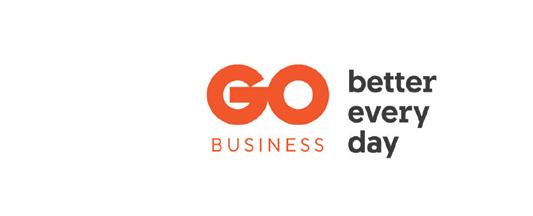
Your Technology Solutions Partner go.com.mt/business With GO Business, your team can make a success of every opportunity. Find out more about our solutions at:
IN THIS ISSUE
08
>>
GOVERNANCE
Malta tops Europe’s digitally enabled countries
Lea Hogg speaks to Hon. Silvio Schembri, Minister for the Economy, European Funds, and Lands, to learn about his vision to create ‘a digitally enabled country empowering its people, communities, and entrepreneurs through the intelligent and universal use of ICT’.
>> COMMERCE From IT to AI... How is tech affecting business?
As the world emerges from the COVID-19 pandemic, Giselle Borg Olivier speaks to Marisa Xuereb, (former) president at the Malta Chamber, to learn about the impact of tech on the business sector in Malta.

>>
TECH
Building for tomorrow
Wayne Grixti, chief executive officer at Tech.mt, talks to Techmag about its focus on internationalisation, business development, and fostering digital skills in schools to address the demand-supply gap for qualified tech talent.
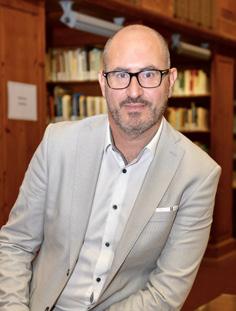

>> GOVERNANCE Finding the right niche
The current review of the Malta Digital Innovation Authority Act will create a much more agile legislative framework, as CEO Kenneth Brincat explains. But 2023 will see many other initiatives rolled out.
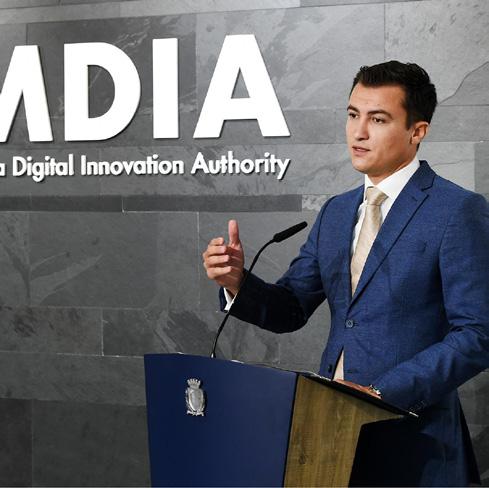
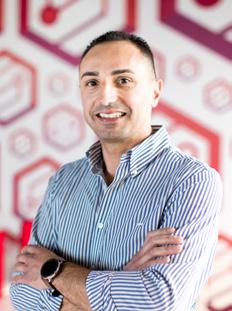
DIGITAL SKILLS 50 shades of techsavvy
>>
The eSkills Foundation has several attractive solutions to ensure that Malta has enough digitally qualified people for the economy to grow. Vanessa Macdonald met with Carm Cachia.
24 32 36 28
>>
RESEARCH
True grit
Can a research project from the University of Malta be the “next big thing”? Researcher Dr Robert Camilleri from the University of Malta thinks so.
>> START-UPS
Harnessing the start-up-investor connection
Techmag looks at how the role of Malta Enterprise has changed over the decades.
>>
EDUCATION
Licensed to skill
Dayna Camilleri Clarke met MCAST’s IICT director, Conrad Vassallo, to discuss how the department prepares a dynamic tech-savvy workforce.
>> EDUCATION
Think different Dr Margaret Mangion, The Edward de Bono Institute for Creative Thinking and Innovation’s new director, speaks to Dayna Camilleri Clarke.
6 TECHMAG CONTENTS
12
22 18 14
>> POLICY DORA
The Digital Operational Resilience Act (DORA) and the NIS2 are two new pieces of European law that will fundamentally reshape the financial services industry. Dr Ian Gauci continues.
>> ECONOMY
Why we need an ICT employment strategy
JP Fabri stresses the importance of a sectoral employment policy and collaboration between government, industry, and the education and training sectors.
>> INNOVATION
How governments can foster growth
Innovation is the key to a brighter future, but it does not happen by chance. Theo Dix elaborates.
38 42 46 48
>> TECH FOR GOOD
Technology’s role in empowering ALS patients
Dayna Camilleri Clark talks to Bjorn Formosa, founder of Dar Bjorn, about his hopes for a more sustainable and inclusive world.
>> TECH FOR GOOD Meet Malta’s
blade runner
Dayna Camilleri Clarke caught up with Antonio Flores, semi-professional Paralympic athlete, to learn more about his incredible journey as he prepares for the next world para athletics championships.
62
>> START-UPS
Emerging talent requires hard truths to grow


Asking a start-up founder to go from idea to global market leader is a big ask. Adrian Galea explains.
66
>> METAVERSE
How can a Web 2.0 company include Web 3.0 in its strategy?
You have probably already heard of Web 3.0. Well, the topic is getting trendier every minute. Alexandre Hardouin expands.
52 68
>> ESPORTS
It’s never just a game!
Lyndsey Grima speaks to Justin Mifsud, founder and CEO of World Pro Racing, about how he turned his racing dream into a reality.
CONTRIBUTORS
ADRIAN GALEA is a venture capitalist and portfolio management professional for early-stage start-up investors. He also manages a Facebook group called Malta Start-up Space that inspires start-up culture in Malta.
ALEXANDRE
HARDOUIN is the founder of Metarchitect Studio (a team of dedicated professionals passionate about the metaverse) and a serial entrepreneur. He’s a former tech investment banker, passionate about Web 3.0 and entrepreneurship.

DAYNA
CLARKE is a senior speech therapist by day and featurewriter by night. When she’s not busy fixing words, she is travelling the world to add to her fridge magnet collection.
GISELLE BORG
OLIVIER is a freelance writer, proofreader and social media marketer who survives on Instagram and cappuccino.
IAN GAUCI is the managing partner of GTG. He advises multiple government bodies and is one of the local key figures on technology law matters. He is also an international speaker, lecturer and author. Ian is recognised as a Tier 1 leading individual in fintech by Chambers and Partners and Legal 500.
JP FABRI is a founding partner at Seed, a boutique advisory practice. An economist by profession, he is also a visiting assistant lecturer at the University of Malta.




LEA HOGG produces and hosts a popular current affairs tv show. She provides multi media content, analysis, forecasting and assessment reporting for a number of international corporates.


LYNDSEY
GRIMA is a freelance writer and social media marketeer. When she’s not typing away, you will find her focusing on her training at the gym.
THEO DIX is a senior manager leading EYParthenon, the global strategy consulting arm of EY in Malta.

VANESSA
MACDONALD had every intention of retiring but so far has been caught up by exciting freelance projects and voluntary work.
7 TECHMAG
Malta tops Europe’s digitally enabled countries

8 TECHMAG
GOVERNANCE
Lea Hogg speaks to Hon. Silvio Schembri, Minister for the Economy, European Funds, and Lands, to learn about his vision to create ‘a digitally enabled country empowering its people, communities, and entrepreneurs through the intelligent and universal use of ICT’.
Malta is recognised as a centre for all disruptive technologies, from AI to fintech, the internet of things, blockchain, and iGaming, whilst it outperforms other European countries in delivering digital government services.
Responsibility for implementing a digital economy falls under the Ministry for the Economy, European Funds, and Lands (MEFL) in collaboration with Tech.mt, Malta Communications Authority (MCA) and the Malta Digital Innovation Authority (MDIA).
The government’s vision is for Malta to be a digitally enabled country with the intelligent and universal use of ICT empowering its people, communities, and entrepreneurs.

9 TECHMAG
ICT is considered a key enabler for advancing the local economy and one of the strategic pillars of Malta’s development. To learn how the island intends to maintain its leadership position, Minister Schembri explained that the government focuses on supporting the sustainable growth of tech companies based in Malta and ensuring that “our jurisdiction remains at the forefront of the digital sphere”. He believes that “Malta’s trajectory is based on placing innovation and the user at the centre of our ecosystem”.
Keen to attract companies seeking to base themselves in Europe, the government says it is taking a proactive approach. It continues to identify new niches and
promote the benefits of Malta’s supportive framework.
Meanwhile, the Malta Diġitali Strategy encompasses a variety of initiatives and policies aimed at enhancing digital infrastructure, boosting digital skills, fostering innovation and entrepreneurship, and promoting the expansion of digital industries.
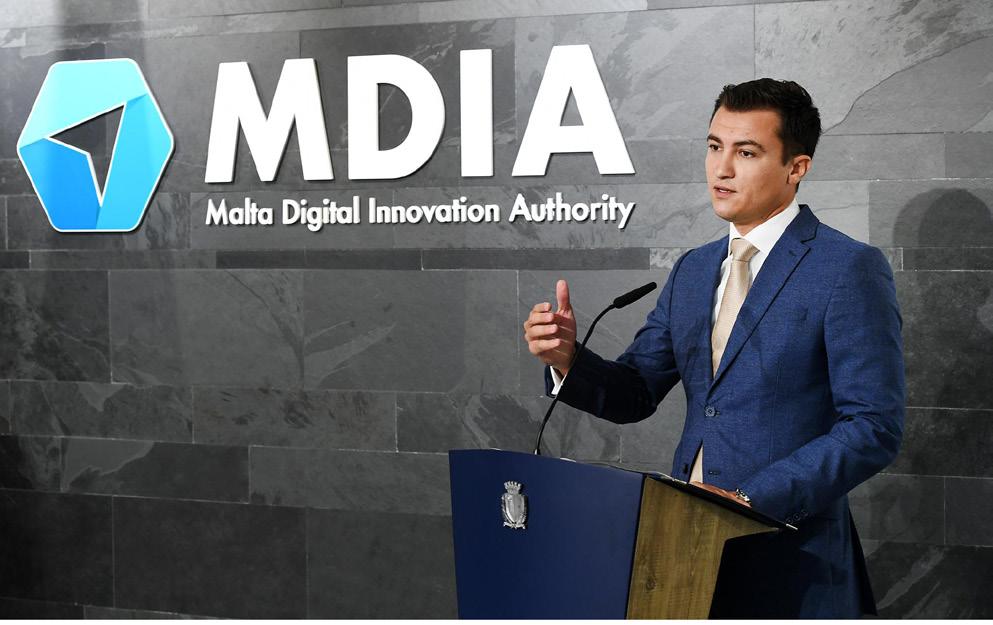
Minister Schembri says the comprehensive plan outlines how the government will enhance and improve the digital economy.
Traditional organisations continue their digital transformation journey, but in the minister’s view, both conventional and digital practices will play “significant roles in promoting economic
growth and development in the economy’s future”.
Economists agree that it is unlikely that the digital economy will completely replace traditional techniques. Still, the minister foresees the expansion of the digital economy accelerating to become “an increasingly important element of the entire economy”.
An EU report on GovTech practices identified opportunities to use technologies for better education, personalised healthcare, and more efficient administration and digital transformation of the public sectors and SMEs to minimalise societal gaps.
Asked if the government’s
plan aligns with this ambition, Minister Schembri confirms that the government aims to establish relationships with innovative start-ups and SMEs to “accelerate digital transformation and reduce socio-economic gaps”. His rationale is that start-ups and SMEs are frequently at the forefront of innovation, contributing new ideas, strategies, and tech advances. Adding “that [SMEs] might assist governments in addressing complex challenges and delivering improved services to residents. Governments can also cultivate a culture of innovation and entrepreneurship by partnering with start-ups and SMEs, leading to new employment and economic growth”.
10 TECHMAG
Photo: DOI / Pierre Sammut
Several governments across the globe have established GovTech initiatives and programmes to create collaboration between the public and private sectors, stimulate innovation, and accelerate digital transformation. These activities include funding and assistance for GovTech start-ups and SMEs, forming innovation labs and incubators, and developing open data initiatives to encourage the reuse of public sector data.
The minister contends that collaborations with creative start-ups and SMEs are “a key process for governments looking to accelerate digital transformation and reduce socio-economic disparities. These GovTech initiatives may play a significant role in this endeavour, and many governments worldwide are currently investing in these programmes to foster innovation and enhance public services”.
Malta is ahead of the curve in adopting and utilising eGovernment services, with the percentage of users exceeding the EU average of
72% (DESI 2021). When asked what benefits can be derived from using and accessing open data, Minister Schembri said he believes that open data “can be a key instrument for improving government transparency, accountability, and innovation. Governments may empower citizens, entrepreneurs, and researchers to produce new insights, apps, and services that benefit society by making data accessible to the public”.
Asked if there was momentum behind the adoption, the minister points out that a good number of national governments worldwide have acknowledged the significance of open data and have undertaken programmes to increase its accessibility and utilisation. In the European Union, the Open Data Directive is there for Member States to make certain types of public sector data available for reuse by members of the public and businesses. With increasing reliance on digitisation, cybersecurity concerns governments, individuals, and enterprises. The minister was asked about the safeguards the government has in place
concerning eCommerce and digitalisation.
“As a country, we know safeguards must be implemented to protect the whole spectrum, be it the service provider and the customer”, the minister says, adding that “cybersecurity is paramount, both in the public and private sectors. The Malta Digital Innovation Authority has been identified as our National Cybersecurity Certification Authority. Indeed, MDIA recently launched the ‘Mind the Gap’ scheme in collaboration with Tech.mt and the Malta Communications Authority – all three entities fall under my remit. It is designed to empower eCommerce businesses in Malta to understand and improve their cybersecurity maturity levels while complementing other national initiatives by the National Cybersecurity Coordination centre”.
Governments worldwide relied on data-sharing platforms to gather early statistics during the COVID-19 pandemic. All this information was safely shared and made possible through cloud sharing. The minister discussed how the government could benefit from using this technology and what similar plans it must adopt.
“There are numerous potential applications for data sharing and cloud sharing technologies that the Government can leverage in the future to improve service delivery, boost efficiency, and foster innovation,” says the minister. He identifies several potential advantages, including improved
transparency and accessibility and real-time analytics to give more insight into constituents’ needs and preferences, allowing the government to make more informed decisions.
In his view, cloud-based sharing solutions will help the government communicate more efficiently across departments and agencies, eliminating silos and increasing information exchange. And by lowering the need for physical infrastructure and enabling more effective and simplified operations, cloud-based collaboration tools can help the government be more efficient and have more streamlined workflows.
In closing, the minister spoke about how technology improves the notion of good governance. His response is unequivocal.
“Malta’s technology assurance framework is based on the principles of good governance. Accountability and transparency are key values. For example, introducing a forensic node requirement in our voluntary certification programmes ensures that all relevant events and data are recorded faithfully in realtime without risk of omission or corruption, guaranteeing tamper-proof, accurate and accessible information,” he says.
“During the last European benchmark, Malta emerged as the top-ranked country in eGovernment, showing our consistent approach across services for industry and citizens,” Minister Schembri added.
11 TECHMAG
Malta’s trajectory is based on placing innovation and the user at the centre of our ecosystem.
FROM IT TO AI...
HOW IS TECH AFFECTING BUSINESS?
As the world emerges from the COVID-19 pandemic and seeks to re-establish a sense of normalcy, Giselle Borg Olivier speaks to Marisa Xuereb, (former) president at the Malta Chamber, to learn about the impact of tech developments on the business sector in Malta.
The Chamber is an iconic institution, having just celebrated its 175th anniversary. What is the Chamber’s point of view regarding innovation within the business sector?
Innovation is a mindset. It is about constantly looking for smarter ways of doing things and more innovative things to do. In competitive markets, businesses thrive on innovation because customers continually seek better deals, more sophisticated products, and superior services. However, companies must invest in people and technology to stay on top of the game. The combination of the two typically delivers the most innovative solutions.
What actions are being taken to keep the Chamber relevant and up-to-date with the current local business and tech industries?
The Malta Chamber is more engaged with local businesses and the tech industry than ever. However, engagement is a twoway street. The more initiatives the Chamber takes to provide businesses with opportunities for networking and learning, the more businesses gravitate towards it. The value of the connections that are facilitated by the Chamber and the visible platform that the organisation provides is being appreciated much more by the local business community.
The 2023 Economic Vision mentions the lack of skilled workers and, in general, the lack of employee resources in the private sector. Given Malta’s influx of iGaming and tech operators, what more must be done to fill the gaps and address the market’s needs?
We need sound labour market strategies that attract talent to the country and enable us to retain such talent long-term. The Malta Chamber has repeatedly recommended that skilled workers are provided with a 3-year extension on their employment licence after the first successful year of employment and are facilitated to relocate their family to Malta. This will encourage skilled workers to pursue long-term careers in Malta. Family relocations will also mitigate the problem of low birth rates and promote better social cohesion.
12 TECHMAG COMMERCE
The Malta Chamber has stated that it will continue to support a rethink of compulsory education. What changes need to be made to the educational system? And what technologies do you think will be essential to the educational system?

We need a radical overhaul of our education system, from one overly preoccupied with assessing the retention of standardised academic knowledge to one focused on developing broad skillsets in all students, irrespective of their academic predisposition. This will ensure that future workers will be more employable and motivated to learn.
The use of technology in education helps expose students to the latest software and devices from a young age. But even more important than the use of technology is the thought process that is triggered in students. Learning is not improved by simply spending money on technology. It is more about thinking about making the best use of the resources available, whether human, technological, or conventional.
What goals do you want to achieve during your tenure at the Chamber, specifically within the digital era? The Chamber is a very dynamic organisation. You cannot sit at the helm of it and think about what can be achieved during your tenure. You need to think way beyond that. The ambition of every President of The Chamber needs to be to strengthen the organisation so that it can achieve more, not just in the immediate term but for many years to come.
As with all businesses, the digital aspect of running an organisation like the Chamber has become crucial. However, the extent to which one can capitalise on the opportunities provided by digitalisation depends significantly on the skills of your people. So while we continue to invest in digital media channels and business process software and hardware, our greatest asset remains our people: our staff and our members. Therefore, my top priority was to ensure that our team and our members are more engaged and empowered to ensure that the Chamber remains the most well-resourced, well-connected, informed, influential, and thought-provoking business organisation within the country.
13 TECHMAG
We need a radical overhaul of our education system— one focused on developing broad skillsets in all students, irrespective of their academic predisposition.
building for tomorrow
→ Inside Tech.mt’s long-term vision

14 TECHMAG TECH
Tech.mt is a public-private partnership between the Government of Malta and the Chamber of Commerce, Enterprise, and Industry. Its goal is to promote, encourage, innovate, and embrace talent in the tech industry. Wayne Grixti, the chief executive officer at Tech.mt, talks to Techmag about Tech.mt’s focus on internationalisation, business development, and fostering digital skills in schools to address the demand-supply gap for qualified digital and tech talent. He also shares the organisation’s long-term vision, which includes internationalisation, foreign direct investment, business development, and innovation as critical factors for growth and success.
A re Tech.mt’s objectives different from previous years?
Let’s remember that Tech.mt is a public-private partnership between the Government of Malta and the Chamber of Commerce, Enterprise, and Industry. So, we have the luxury of having the best of both worlds: influence on policy and regulation on the one hand,
and the pulse of business and the private sector on the other. Tech. mt is the bridge between these two pillars of the tech ecosystem in Malta. The goals remain the same, and the specific objectives and approaches to achieving them change and will continue to change. The prominence of internationalisation as the vital ingredient for growth and the increase of tech resources on

15 TECHMAG
Tech.mt is the bridge between the two pillars of the tech ecosystem in Malta.
the island evolved, but ultimately the mission to assist, promote, encourage, innovate, and embrace talent remains, as coined by the founders in the deed back in 2019.
Our ambitions are fuelled by our commitment to harnessing the power of technology. We aspire to continue working with academia and employers to expand tech skills and talent in the digital sector and build a smarter state. Our mission remains to create a network for innovation and collaboration across stakeholders and businesses to develop effective policy and regulatory solutions to promote the digitalisation of the economy and drive productivity and inclusive growth.
What role does Tech.mt play in supporting the local tech industry, and how do you ensure you add value to the ecosystem?
Given the expansion of the innovation industry and business landscapes, Tech.mt has designated the internationalisation of local tech companies as a top priority and is taking steps to support their entry into new foreign markets.
In 2021, the productivity levels of the tech sector were more than three times higher than those of the entire economy. Nevertheless, the industry had a high degree of profitability. According to Eurostat’s national accounts data, this sector’s net operating surplus and mixed income in Malta were much more significant in 2020 than in other chosen euro area countries in terms of output and GVA per unit.
In terms of the contribution of the tech industry to the economy, the NSO reported that in 2022, the ICT sector accounted for 7.9% of Malta’s GDP. This shows how important the tech industry

is to small countries like Malta, where it helps the economy grow and creates jobs. These figures emphasise the value of tapping into new markets and capitalising on the opportunities presented by the interconnected global economy.
Our purpose in this regard is to assist businesses in growing. We begin with an in-depth analysis of the numbers, prospects, and proposals to identify business development gaps and gain insights into the opportunities.
We ensure superior client relationship management through personalised advisory services, with innovation as a parameter for development and competitiveness. Also, we always maintain a continuous dialogue with public and private entities to tailor our assistance to specific needs.
16 TECHMAG
Tech.mt intends to organise an annual Global Tech Summit in Malta to bring together tech innovators, investors, and entrepreneurs worldwide to stimulate collaboration and highlight Malta’s increasing role as a hub for developing technology.
Tech.mt intends to facilitate global expansion opportunities by organising and supporting events connecting stakeholders in the tech industry. These events will provide endless possibilities for delegates by showcasing their firms on the international stage. In addition, businesses will benefit from special rates on participation fees for world-renowned physical events that Tech.mt participates in and attends.
Through these avenues, we will present businesses with the possibility of growing and generating brand awareness, connecting with potential investors, and networking with likeminded individuals.
What is Tech.mt’s approach to shaping the future of Malta’s tech industry, and what is your plan to achieve that vision?
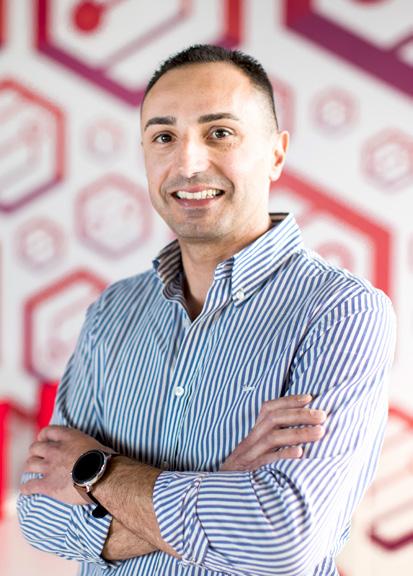

Malta has emerged as a top tech hub, attracting many start-ups
and established companies to its shores. We are launching a brand that exclusively promotes Malta’s resources and assets in collaboration with other organisations and entities. With the outcome of this initiative, we aim to attract foreign businesses to set up shop on the island. About this, Tech.mt will organise several business missions this year to provide opportunities for established corporations and local start-ups to gain exposure abroad and grow their international networks. In addition, the business missions will be designed to facilitate meetings and networking opportunities with potential partners and investors in foreign markets, aiming to foster new business relationships and promote economic growth and investment in Malta.
To promote our local tech ecosystem, Tech.mt intends to organise an annual Global Tech Summit in Malta to bring together tech innovators, investors, and entrepreneurs worldwide to stimulate collaboration and highlight Malta’s increasing role as a hub for developing technology.
This will continue to consolidate Tech.mt’s mission to put Malta at the forefront of the tech industry on a global level. At the same time, we are attracting international businesses to start up, operate, and trial their technologies locally.
What role do you see Tech. mt playing in promoting tech careers, and how will you ensure that you are making progress in these areas?
Tech.mt recognises these challenges and seeks to address them by creating opportunities to foster digital skills in schools at a young age. In addition, we aim to address the demandsupply gap for qualified digital
and tech talent that recruiters often encounter. This approach is crucial in ensuring all individuals have access to the resources and training necessary to participate fully in the digital economy.
We are encouraging students from the early years to take up techrelated subjects. Tech.mt believes that technology is persistently present across many industries, and therefore, digital skills are as relevant as core subjects. We aim to take a comprehensive approach that considers multiple factors and involves collaboration with others to maximise the impact of our initiatives.
What is your long-term vision for Tech.mt?
As we look to the future, Tech. mt’s strategic direction is focused on business development and internationalisation, foreign direct investment, tapping new markets, and targeting the challenge of the supply of tech-savvy human resources.
Innovation is critical to our growth and success. We will continue to invest heavily in research and development to create new and innovative solutions that push the boundaries of what is possible. In addition, we plan to focus on identifying new opportunities for growth and diversification. This will involve expanding our service offerings and developing strategic partnerships with key stakeholders.
We will remain agile and adaptable, continuously evaluating and adapting our strategic objectives to ensure we are on track to achieve our goals. With this strategic direction in place, I am confident that we can create a brighter future for Tech. mt and continue to be a leader in the local tech industry.
17 TECHMAG

18 TECHMAG
Photo: MaltaCEOs magazine / Bernard Polidano
the right niche
The current review of the Malta Digital Innovation Authority Act will create a much more agile legislative framework, as CEO Kenneth Brincat explains. But 2023 will see many other initiatives rolled out.
When the Malta Digital Innovation Authority was set up in 2018, digitalisation was not yet the buzzword it has since become in the corporate world. Despite new technology being churned out at a dizzying rate, it took time to anticipate how it would be adopted. However, one thing was clear: whatever lay ahead, Malta was ready.
Just as had happened with financial services and online gaming, having a robust but flexible regulatory framework would give the island an advantage. But now, five years later, the time had come to pause, to reflect on what had happened to technology over those years, to assess what other countries were doing, and to identify where Malta could compete with a unique selling point.
Kenneth Brincat, the Authority’s chief executive officer, made drawing up a strategy for the coming three years his top priority when he took over in 2021. The frank analysis of strengths, weaknesses, opportunities and threats showed that Malta could carve out a significant niche and that the Authority could have an essential role in drafting the required changes and handling any activity generated, but only if specific bottlenecks were eased— and only if the vision was honed in to reflect all that had changed in the world of digital innovation since 2018.
The CEO, who spent 18 years leading management of various local councils and then as a chief operations officer at the Malta Business Registry, is not given to hyperbole. He stressed that the last annual report did not trumpet numbers because these are different from the metrics that they wanted to be measured by: the aim is to add longterm value to the Maltese economy, which is of a qualitative nature.
“Take, for example, the framework for cryptocurrency regulation, which was very robust. We are well aware that regulations can scare off some businesses… In fact, at the time, Malta was criticised because other jurisdictions were taking more of the market share. However, given the way that things have evolved, this is something that we should be proud of. The intention was always to go for quality and not quantity.”
The first thing identified by the review was the need for a more agile legislative system. Two Acts currently govern the MDIA: the Malta Digital Innovation Authority Act and the Innovation Technology Arrangements and Services Act.
“If you want to attract investment and empower an authority with the right frameworks, you must be agile and quick.
19 TECHMAG GOVERNANCE finding
This industry changes by the week, not by the month! So we propose the MDIA Act be broadened as an “umbrella” act. The ITAS Act will be changed to subsidiary legislation, while cybersecurity certification will also be covered by similar legislation.
“This will enable us to make changes more rapidly through subsidiary legislation. That will be a ground-breaker for us... However, you must remember that what is innovative today will not be innovative tomorrow!” he explained.
The draft of the new legislation should
“If a system like this is voluntary, there must be some inherent advantage for the person applying, especially considering the costs. Now, the approach is more market-driven, understanding what the market wants, rather than launching something in the hope that it will attract investment,” he said.
Brincat explained that the market is increasingly asking for technological assurance rather than certification. Therefore, the MDIA’s Technology Assurance Assistance Framework (TAAF) is virtually ready and will be launched after the amendments to the legislation.
be ready to go to Parliament before the summer recess, while targeted consultation is currently underway with the affected stakeholders. The feedback, he said, was that the amendments were very welcome.
This is not the only significant change. The Authority had been given a dual role as regulator and certifier. In addition, the ITAS Act meant that anyone with a solution based on Distributed Ledger Technology (DLT) or Smart contracts could have it certified by the MDIA on a voluntary basis, a service that Malta pioneered. However, Brincat explained that this would be tweaked to hone into a more niche area.
“What has changed? Some companies are spending a lot of money, especially on cybersecurity, while others are not. The ones who do invest are coming to us for a trust mark, which gives them credibility and reliability,” he explained.
However, the MDIA has learned from the strategy review and feedback, and the TAAF will no longer have just one category of assessment but four.
“The wonderful thing is that TAAF is technology neutral, so it can be used for anything from a website to DLT. For example, level three would be equivalent to our
20 TECHMAG
“What has changed? Some companies are spending a lot of money, especially on cybersecurity, while others are not.
The ones who do invest are coming to us for a trust mark, which gives them credibility and reliability.
current certification level, which is very robust. They would be required for an entity with a higher level of risk, such as a bank or insurance company. However, a retailer might only need levels one or two,” he explained.
Two other pieces of European legislation are driving change: the EU has enacted a Cybersecurity Act, and the MDIA will be the certification authority for the relevant schemes. EU institutions are also discussing a law governing Artificial Intelligence, which will require local subsidiary legislation. The Authority already offers a testing ‘sandbox’, and five applications – all involving AI – are currently being handled by a team which includes a compliance staff. The MDIA, which
The niche that he has identified for Malta is linked to certification, which needs to be carried out by accredited conformity assessment bodies.
“These bodies can be accredited anywhere in the EU and offer their services through passporting, so if Malta manages to attract these bodies to base themselves and seek accreditation here – and if we can efficiently deal with them – that would be a great opportunity,” he said, explaining that the MDIA was already having talks with the National Accreditation Board on the creation of a fast-track application process.
“We are not anticipating that many companies will come to us for cybersecurity certification as this is only required to be carried out by an Authority in specific cases of high risk… Therefore, the conformity assessment bodies represent a better opportunity,” he said.
Another exciting development will be the establishment of European Digital Innovation Hubs. There will be one in most Member States – including Malta – although larger countries will have multiple regional offices. The MDIA will administer Malta’s Hub, providing a holistic infrastructure – this includes the space, the equipment and the expertise to help those starting up or want to scale up or diversify using alternative technologies.
works from modern offices in Mriehel, now has a headcount of 21 people.
It licenses systems auditors used by the Malta Financial Services Authority (MFSA) and the Malta Gaming Authority (MGA). For example, an MGA licensee might have an element of DLT, or an MFSA licensee might be involved in virtual crypto assets, both of which would need to be audited by one of the MDIA’s licensed auditors.
Brincat stressed that the MDIA would continue to expand its resources, explaining that this was not an area where an Authority could depend solely on outsourcing.
“The idea is ‘test before you invest’,” he said, adding that the launch event will be held on 23 March 2023, with the Hub up and running by the end of this year. The Hub will utilise €2.6 million of EU funds and will be complemented by incentives and entrepreneurship programmes.
This year will also see the first review of the National AI Strategy, launched in 2019, with a review due every three years.
“We are proud to announce that 72% of the action plans in the launch document are concluded or at an advanced stage. We will then be able to publish a revised document to cover the coming three years. Things move very fast, and the MDIA is at the forefront to spearhead the changes required for the benefit of all stakeholders.”
21 TECHMAG
Things move very fast, and the MDIA is at the forefront to spearhead the changes required for the benefit of all stakeholders.
50 shades of tech-savvy
The eSkills Foundation has several attractive solutions to ensure that Malta has enough digitally qualified people for the economy to grow. Vanessa Macdonald met with Carm Cachia.

You would think that coming 6th out of all the EU members in the European Digital Economy and Society Index (DESI) would be enough for Carm Cachia to pat himself on the back, but far from it. Instead, the chief administrator of the eSkills Foundation is trying to come up with long-term solutions to the relentless demand for digital warriors and has identified three main pillars, which are aimed at easing the vacancies in the medium-term while ensuring a long-term pipeline of suitably qualified (and experienced) people.
The Foundation last completed its ICT Skills Demand and Supply Monitor survey in 2021. This concluded that there were insufficient people in the tertiary education pipeline to meet future demand. Moreover, given the size of Malta’s workforce, there is only so much that can be done to increase the number of students taking up ICT careers. Cachia, however, thinks that the situation on the ground is more nuanced, with several employers in great need of associate or technician-level resources who do not necessarily need to be graduates.
“It takes 10-12 years from someone embarking on their secondary schooling to graduation. But the employers I regularly encounter indicate that people with three or four specialised industry certifications, targeting specific industry roles, would be perfectly adequate for their needs,” he explained, adding that apart from software developers, there was also a demand for data scientists and cybersecurity analysts, to name but a few. “It is about time that industry believes that industry certifications are not just a complement to a degree but a credible and reliable alternative path of education as well.”
The Foundation already funds and organises around 60 courses a year – through 14 providers in 2022 – on themes such as ‘emerging technologies’, which appeal to a wide range of people, including business leaders, and more specific ones, as software development for blockchain. What if it were able to harness more funding to be able to offer more industry certification courses?
That is one of the initiatives that Cachia is now working on. It is not the first time the Foundation has been able to tap into
22 TECHMAG
SKILLS
DIGITAL
Integration of Digital Technology Digital Public Services Connectivity Human Capital DESI EU average
DESI (Digital Economy and Society Index) 2022 Malta: DESI rank 6 / DESI score 60.9
funding, but this initiative would be grander than anything done in the past. He believes this could provide a pipeline that could easily cater to the middle-level tranche of vacancies that do not require graduates, apart from offering a career path for those who are not, perhaps yet, interested in tertiary-level studies.
“The University and MCAST are excellent and very proactive, but many people shy away from an academic path. This has emerged very clearly from several surveys. So industry certification courses could provide an alternative,” he said, adding that there were excellent courses by global tech leaders such as Microsoft, Amazon and Cisco, for example, and nonvendor training providers like ISEB, ISACA, CompTIA, (ISC)2.
“There are industry certifications for every skill required by the industry.” It is also very cost-effective: it would cost a few thousand to get someone ready for a particular career path, a fraction of what a foreign graduate programme would cost.
The eSkills Foundation has already asked for more funding from local foundations, some of whom have been helping for the past few years. In parallel, it has negotiated very competitive rates from the training providers. However, Cachia is convinced that more could be done once the funds are available.
“These would be very effective. When we offer a programme for an in-demand theme, all the places on the course are snapped up within a few days…” he enthused.
The second initiative would be to reduce the number of people lacking basic digital skills – around 39% of the Maltese population, even if this is higher than the EU average. Much is already being done by other entities, such as the Malta Digital Innovation Authority (MDIA), which offers courses to almost 2,500 people. Cachia believes that the higher the starting level of proficiency, the easier it would be to shift people to a higher one. The future of work in many positions will require advanced digital skills.
“If you assume that some two-thirds of tech-savvy are employed, then they are exposed to training opportunities which can expand their knowledge. But those who lack basic skills are very often marginalised and have even fewer opportunities to learn…” he said.
The Foundation has both a direct and indirect influence on the DESI. The former is associated with human capital, classified by their levels of digital proficiency. The European Commission complements the local surveys with its analysis. Indirectly, the Foundation contributes to the decision-making processes that affect outcomes by providing irrefutable evidence of the situation and proposing solutions. Every year, for example, it organises well-attended Digital Skills Bootcamps, tweaked each year to reflect the emerging priorities of the country. “Of course, we (and other entities like MDIA, Tech.mt and so on) also need to think long-term and to inspire more students
FACT FILE
The ICT Skills Demand and Supply Monitor note that the demand for digital technology professionals in the EU has grown by 4% annually.
The number of ICT specialists in the EU has grown by 40% between 2011 and 2019, more than six times the increase in total employment.
European agency CEDFOP forecasts that Maltese ICT employment will grow by 21.9% between 2020 and 2030, more than twice the growth rate forecast for the EU27.
In 2021, according to Eurostat, almost 9 million people in the EU worked as ICT specialists, representing 4.5% of the total EU workforce (Malta: 13,300 – 4.9%).
Despite a slight increase over the last decade, women accounted for less than a fifth of the EU27’s ICT specialists (19.1%) in 2021. The highest shares of women among employed ICT specialists were observed in Bulgaria (28.2%), Romania (26.0%) and Malta (25.6%).
from a younger age to consider IT – and not only as a career,” he said. “In the future, if you are not digitally savvy, you will find it difficult to succeed in most sectors, from manufacturing to services. The future will be high-tech. But that approach has to be well coordinated across the island and well integrated into all educational curriculums.”
There is one other suggestion in the Monitor: to import more labour and entice employees by offering flexible remote working or gig working, which is unfortunately not as popular a concept for some employers. However, each solution has implications beyond the eSkills Foundation remit, which is why Cachia believes the other approaches must be tackled in parallel.
There is one other question to tackle: where does the demand come from? Cachia said the perception is that it is limited to some industries sectors – which is not correct.
“The industry is very buoyant, and not just due to gaming: there are many ICT companies which are not small and who employ hundreds. The problem is that many other attractive sectors are enticing, and with a small population, attracting people to one means depleting another… They all compete with each other!” he said. “I think that at some point, we have to accept that we may never be in a position that completely meets the demand. There is no quick fix, but there is a lot more that we can do for the longer term….”
23 TECHMAG

24 TECHMAG
TRUE GRIT
Can a research project from the University of Malta be the “next big thing”? Researcher Dr Robert Camilleri from the University of Malta thinks so, but knows the steep road ahead. He spoke to Vanessa Macdonald.

What sets one researcher apart from all the others? Sometimes it is the ability to take technology that already exists and use it in a completely different way. When Robert Camilleri was puzzling over ways to stop lithium-ion batteries from overheating, the solution came from a tiny element that has for years been used for a similar purpose in laptops, known as a heat pipe.
Camilleri is currently a senior lecturer at the Institute of Aerospace Technologies at the University of Malta. Without exaggeration, the project he is working on could change the electric car industry, not to mention all the other uses that could be found for the new technology.
“Research is the driver for new technologies, but it is often misunderstood. The reality is that it is all about coming up with new concepts and testing them through experiments, models, and simulations. Sometimes they work—but even then, you need to see what advantage they offer and whether they can be exploited commercially.
“Research is very costly. Therefore, negative outcomes are also very valuable, as they prevent other teams from going down that same road for nothing…80–90% of your research tells you what you should not be doing!” he said.
25 TECHMAG
RESEARCH
Given those odds, his achievements are even more impressive. For example, one of the significant problems with lithiumion batteries is that they heat up when charging, making them a safety concern and prone to degrading faster.
“When charging and discharging, batteries generate heat. If not expelled, that raises their temperature. However, the battery chemistry breaks down past a certain temperature and produces even more heat, entering a vicious loop called thermal runaway. This is a safety concern which would lead to the batteries catching fire,” he said, adding that the overheating was even more of a problem when batteries were fast-charged.
Early versions of battery packs were simply not cooled. Still, as customers demanded faster charging of their
to wait 8-10 hours for their car battery to recharge.” So, Camilleri found a way to improve the fastest fast-charging rate by a factor of about five, which makes it very interesting to businesses.
“We know that boiling a liquid requires a substantial amount of heat. So we use the heat generated by the batteries to turn our liquid into gas. We worked on a coolant liquid whose boiling point is 35⁰C (the comfort temperature of lithium-ion batteries), which enables the thousands of batteries in a car to be cooled equally.
“This has three advantages. First, the cooling solution can remove a large amount of heat, meaning that we can cope with fast charging, which dumps a high current rate into the batteries. Second, it enables the thousands of cells forming the car battery to remain at a
certainly did—then funding is possible. Although easier said than done…”
Even though priorities vary across academics, he believes that the essential element in research is having a paid employee—rather than relying on students—who would be immersed on a long-term basis in the project, raising the stakes for success, particularly when you need regular interaction with industry.
This is the area where Camilleri felt that Malta could grow: “The usual career path here is from a PhD to a lecturing post, which is not the case abroad. But, of course, the issue is keeping people once you find them, as they will move on at the end of a project unless there is another one to move to.”
But apart from the researcher, you need funds for the patenting – a process that the university’s Knowledge Transfer Office facilitates. The patent would be issued in the university’s name, identifying him as the ‘inventor’.
vehicles, manufacturers began to develop proprietary thermal management systems to cool them down, ranging from fans to cool the air to placing the batteries on a cooling plate, with the immersion of the batteries in oil being another potential solution. Every strategy, however, came with its own set of problems.


“And of course, for electric cars, this is what customers want; they do not want
single temperature—the boiling point. This removes any weak links associated with other cooling methods. Third, it enhances safety,” he explained. Camilleri explained that the discovery was not an overnight “Eureka” moment but a series of events dating back to the time of his doctorate. This was when he thought about the heat pipes in laptops, which have a fluid inside that boils.
“The intellectual property needs to be registered in different countries, so the costs escalate quickly,” he said, adding once again that commercialisation is “easier said than done”.
“Through my PhD at Oxford University, I was lucky to have contributed to developing an electric motor. This was spun out into a company, and in 2021 it was bought by a top car manufacturer. However, despite the well-organised machine that it had behind it—which is
26 TECHMAG
Research is the driver for new technologies, but it is often misunderstood.
Test piece showing a single dummy cell mounted with wick (centre) Test chamber mounted with a fan cooled heat sink
Test results comparing NEVAC cooling with natural cooling for various battery heat losses
Oxford—it took the university and the start-up ten years of development and funding before they got acquired.
“They hit the jackpot—and the revenue would help them recoup all they had spent and fund other projects. But they are the exception that proves the rule. Everyone thinks that if you have a breakthrough, you will get rich. But, unfortunately, it doesn’t work like that!” He laughed ruefully.
Indeed, for researchers, it is tempting to move to industry—statistics worldwide show that 60–70% of PhDs do so—which can throw funds at a project in a way that a university can only dream of. So, what keeps people like Dr Camilleri in the field? He shrugged. “I always thought I would return to industry—a local company, Seifert, sponsored my PhD. I am very grateful, but somehow my engagement with them fell through. As an academic, I now pursue research that can have an impact.”
Researchers rate the level of progress using the same ‘Technology Readiness Ladder’ that NASA had used for getting to the moon, with levels from one to nine. Universities typically operate between
there is prototype manufacturing, testing in the real world, certification, and release to the public.
“With the battery project, we are at around level four or five. This is as far as
with industry players who can take it further. The battery project, NEVAC, is now at that crucial stage: the technology is done and tested, but I want to build a functioning prototype,” he explained.
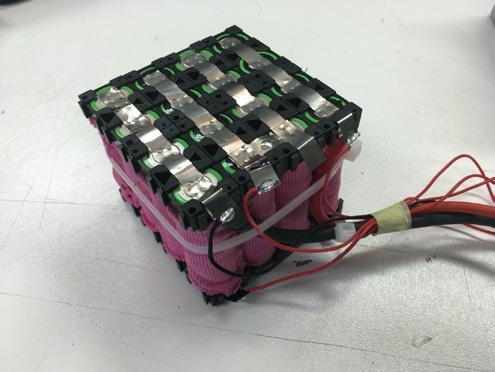
“We have not had that many successes here in Malta, although we have had three spinout companies from the University of Malta. Nevertheless, there are several exciting projects, especially in the medical field. We are not lacking ideas. What we need is the structure and the culture to keep pushing to get the technology noticed. We must understand that you need to put money into it and that it is difficult to justify pouring more and more in.”
Even catching the attention of the industry is not always enough. Camilleri names a top company that was interested
we can push it on our own. We are now trying to secure investment and engage
in the technology; the first round of meetings was successful from a scientific
point of view, but Camilleri admitted that they had come back aware of how much more needed to be done from a marketing and business plan point of view. This is one of the reasons that the MCST insists on projects having an industry partner who can inject that commercial approach.
“It’s a healthy relationship,” he said, adding that the project partner was battery technology firm Abertax.
All this is even more challenging when you realise that the team is—now—alone, as the researchers have moved on.
Having a brilliant mind and making breakthroughs, it is clear that this is only the start. What you need to succeed as a researcher is a degree of tenacity that is hard to find. Camilleri laughed, saying, “At university, we called it “grit”... That is the only way to succeed.”
27 TECHMAG
80–90% of your research tells you what you should not be doing.
Natural Cooling Temperature [°C] Time [s] 50 35 45 30 40 25 20 0 4000 3500 3000 2500 5W NEVAC Natural cooling 5W 1W 1W 3W 3W 2000 1500 1000 500
A prototype of the battery pack with NEVAC cooling system

28 TECHMAG START-UPS
Techmag looks at how the role of Malta Enterprise has changed over the decades, with the start-up festival held recently a vivid example of how it wants to harness the start-up-investor connection.
In Malta’s post-independence days, young men—and, to a lesser extent, women—started to yearn for a career that was not tied to the dockyards or public administration. This future was offered by the entrepreneurs putting down roots in Malta, linking it to the flourishing markets across the seas. It is hard to recognise that world nowadays, with investors comparing the competitive edge in various jurisdictions—going well beyond tax incentives.
In this context, the recent flurry of activity at Malta Enterprise’s Start-up Festival in Villa Bighi must be seen. The island’s economy
survived the financial crisis of 2008/2009 and the COVID-19 pandemic with, in practical terms, full employment. Clearly, the focus had to be on quality rather than quantity.
The challenge is not to resist change but to move with it. This is one of the reasons that the second Startup Festival organised by Malta Enterprise was one to watch and why it is well on its way to going from being an experiment to an annual event.
Anthony David Gatt, the chief of marketing and media relations at Malta Enterprise, was thrilled
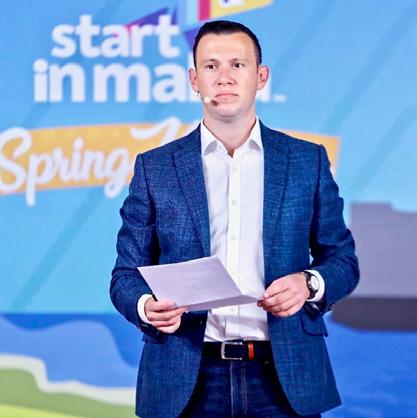
29 TECHMAG
Anthony Gatt
by the outcome: over 500 registrations, more than double those of the first event. Hundreds of youths from 30 schools could view the stimulating array of entrepreneurial opportunities and be inspired by investors and business angels with their stories of success—and of failures that were turned into lessons for success.
But the Start-up Festival was not only about visitors and participants but also about how the next decade will shape Malta. And the vision is unmistakable.
“A few years ago, we looked at our incentives and realised that, as good as they were, they needed to be tweaked. So we now have a more robust and effective financial support offering. However, it is not only about funding. Creating an ecosystem is crucial for start-ups to flourish—events, funding options, infrastructure, and frameworks,” he said, adding that this vital insight came from experiencing successful global jurisdictions ranging from Lisbon to Helsinki to Palo Alto.
“We are looking at bringing over companies with high valueadded, good-quality jobs, but on a smaller scale. If we are going to recruit ten artificial intelligence experts with good wages, that is economic growth, and that is the type of growth that we at Malta Enterprise—up to the CEO and board level—have been pushing for. Where to start? We need to show
innovative start-ups that we can support them in a competitive way. And this cannot just be rhetoric or good marketing!”
“Our relationship managers are in touch with them every few weeks; this is the rapport that makes the difference between selling Malta and welcoming these companies effectively!”
Improving the local investment mix offering is also high on Malta Enterprise’s agenda. This was addressed during the recent Startup Festival, specifically through an international company specialising in this matchmaking setting up a ‘deal room’.
The festival brought over 13 business angel investors for the first time in Malta. “We set up over 250 meetings, and the deal room was completely sold out,” he exclaimed.
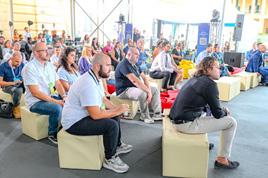

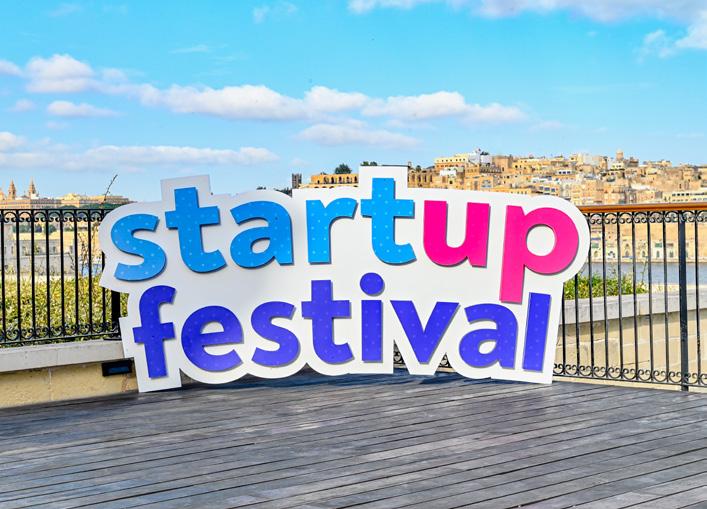
30 TECHMAG
Globally renowned start-up accelerator Plug and Play also took to the stage, hot on the heels of launching their services in Malta.
“They will be here for a few months every year, offering masterclasses to help those interested refine their pitches and create more international linkages via this prestigious network,” he said.
The same buzzwords get thrown out far too often, diluting their importance. For example, halfway through the interview, Gatt had still not used the word “sustainable”, which is one of the thrusts of Malta Enterprise’s strategy.
“I did not use the word for that reason! But the point about sustainability is what are we
The festival was also used by Malta Enterprise and the Residency Malta Agency to launch a start-up residency programme aimed at non-EU founders – ranging from the UK and the USA to Turkey and Israel. The scheme provides successful applicants and their family members a residency permit for three years, renewable for an extra five years. It also provides a residency permit for the key employees and their family members for three years, renewable for an additional three years. Gatt believes this scheme will give positive results; however, Malta Enterprise will keep an eye on the projects to ensure they deliver.
“We would like them to establish roots here. But on the other hand,
for such valuable flows… Malta Enterprise is here to facilitate those matches, help improve
really talking about: financial sustainability, ecological sustainability… The Malta Enterprise’ Smart and sustainable investment grant’ is precisely aimed at this: up to €50,000 for each approved project – available not only to international start-ups but also to local companies – that can make ‘green’ pay in a way which goes beyond just ticking boxes.”
“Malta has a thriving maritime economy, and the green economy is just as full of exciting possibilities. And there are so many innovative start-ups that want to do something good for our society: youths today have this affinity with social change. They know the future that they want for themselves.”
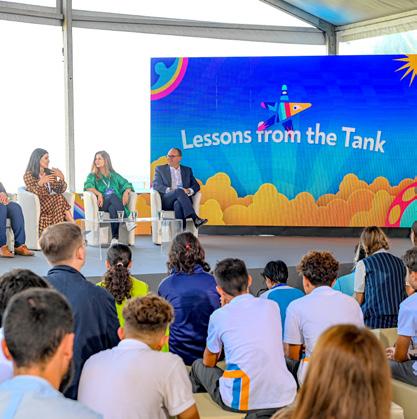
other Maltese entrepreneurs are after international talent and investors. Malta can act as a host
our economy, and solve local and global challenges through entrepreneurship.”

31 TECHMAG
We want to create the right environment where local start-ups and scale-ups can meet new investors that can help mentor and fuel their growth to the next phase.
LICENSED TO

32 TECHMAG
SKILL
EDUCATION
Creating the tech minds of tomorrow, today
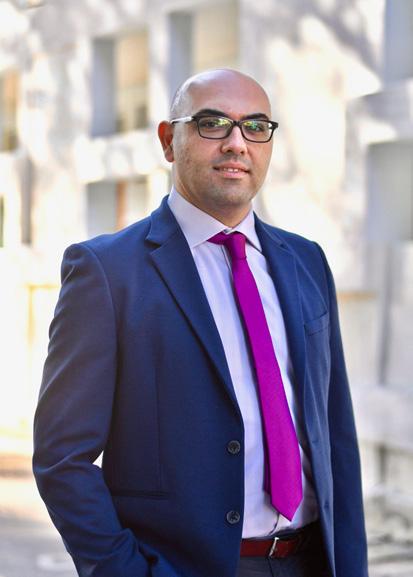
Dayna Camilleri Clarke met MCAST’s Institute of Information and Communication Technology (IICT) director, Conrad Vassallo, to discuss how the department prepares a dynamic tech-savvy workforce through diverse vocational training and qualifications and investing in a multi-million-euro ICT hub within the Paola campus.

33 TECHMAG
“There’s still a prevailing stigma that studying at MCAST is inferior compared to other academic routes, but that really couldn’t be further from the truth, and fortunately, we are seeing that stereotype shift”, begins Vassallo.
“Over ninety per cent of the institute’s graduates find work related to their chosen area of study. This year’s admissions data shows that ICT is one of the institutes that attracts the most applications. Moreover, our students have achieved incredible success; whether forming part of a global tech company or becoming entrepreneurs, it’s ever-rewarding to hear what our alumni are accomplishing.”
Vassallo is one of the first founding lecturers of the institute. Having worked at MCAST since 2001, he firmly believes that learning is an active, constructive process where humans construct knowledge and meaning from their experience. Over the decades, he has seen the ICT sector change immensely within education and the local economy. “As a department, we have grown considerably since 2001. As a result, we attract high-quality lecturers and industry experts who are proud to associate themselves with MCAST and genuinely care about the student’s learning pathway.”
When asked if enough is being done to meet the skills gap for ICT professionals in Malta, Vassallo quickly replied, “Absolutely. As Malta works to strengthen the iGaming sector of the economy, we are working closely with industry leaders and recognised brands to ensure we provide world-class certifications specific to this industry. As a result, we are helping to guarantee that our students achieve the required skill set to work for the
game development industry locally and internationally. For example, our Advanced Diploma in iGaming (the next level up from the diploma route) provides hands-on experience to learners targeting junior roles in this forward-thinking sector. It can also serve as a precursor to degrees in software development, iGaming, digital games, or business analytics. This two-year programme balances core software, web, and mobile app/game development skills alongside advanced digital marketing, SEO, database design and implementation, advanced mathematics, data analytics, and visualisation. The first year of this programme focuses on providing learners with core development skills, whereas the second year provides further specialisation and puts the core skills to good use through workbased learning. This is just one example of a course where we meet a local need to upskill individuals. This September, we also have two new degree programmes launching.”
That said, as much as we are reacting to address the skills gap, we cannot assume full responsibility for the training of our students. By that, I mean we need companies to be prepared to take our interns and offer vocational work-based learning experiences. It’s a two-way street. We need more entities to come forward and support our educational system. We strongly believe vocational education helps prepare our students for the wider workforce and gives them both the technical prowess and the soft skills to commence full-time employment. Unsurprisingly, most students provided with this hands-on opportunity successfully engage with the supporting placement company after graduating.”
Vassallo explained that MCAST is also developing a new state-of-the-art building for its Institute of Information and Communication Technology (IICT) as part of an EU-funded project. The brand-new hub is set to open later this year.

“The new IICT building, costing 13 million euros, is part of the college’s efforts to establish itself as an international centre of excellence in vocational education and training (VET). The building is on the Paola Campus, opposite the new Resource Centre, and houses the impressive two-storey library. In addition, it will include 58 learning spaces, including computer and network labs and lecture rooms, 13 offices, and a 500-square-metre multipurpose space. The IICT hub is set on four floors, with a footprint area of 2,200 square metres and a gross floor area of 12,000 square metres.
Vassallo added, “Overall, this is a really exciting time for the college, and the investment in purpose-designed buildings is unprecedented. The IICT building will help us shape the next generation of professionals in the sector. We will continue to work with the industry to ensure that the college plays a key role in shaping Malta’s education and training and the country’s future leaders and workforce. We now look forward to the opening of the building to keep offering our students first-class facilities and increase the number of learners making MCAST their first choice.”
34 TECHMAG
Over ninety per cent of the institute’s graduates find work related to their chosen area of study.
Established in 2001, the Malta College of Arts, Science, and Technology is the country’s leading vocational education and training institution. MCAST has six institutes in Malta and a campus in Gozo. Its six institutes in Malta and its Gozo Campus offer more than 190 full-time and 300 part-time vocational courses, ranging from certificates to doctoral level (MQF Level 1 to Level 8). The six MCAST institutes, namely the Institute of Applied Sciences, the Institute for the Creative Arts, the Institute of Engineering and Transport, the Institute of Business Management and Commerce, the Institute of Community Services, the Institute of Information and Communication Technology, and the Gozo Campus, provide all the technical and professional expertise towards the delivery of the programmes at MCAST. They also aim to drive forward all the study areas under their respective responsibilities. This corporate structure enables focused strategies that address students’ specific needs at each level while maintaining a healthy dialogue with all interested stakeholders to provide the best programmes for the needs of the local economy and society.

The Institute of Information and Communication Technology offers part-time and full-time study programmes in software development, multimedia, iGaming, computer systems, networks, and business analytics. The current list of full-time programmes currently being offered by the MCAST Institute of ICT includes:
• Introductory Certificate in ICT
• Foundation Certificate in ICT
• Diploma in ICT
• Diploma in iGaming
• Advanced Diploma in IT (Multimedia Software Development)
• Advanced Diploma in IT (Software Development)
• Advanced Diploma in IT (Computer Systems and Networks)
• Bachelor of Science (Honours) in Computer Systems and Networks
• Bachelor of Science (Honours) in Software Development
• Bachelor of Science (Honours) in Multimedia Software Development
• Bachelor of Science (Honours) in Business Analytics
35 TECHMAG
THINK different
The Edward de Bono Institute for Creative Thinking and Innovation at the University of Malta has been helping people find their creative potential for decades. Its name is synonymous with new ways of thinking. Dr Margaret Mangion, the department’s new director, was appointed in recent months. Dayna Camilleri Clarke met with her to find out more about it, including how it is still celebrating its 30th anniversary and how it is changing its focus to include new learning pillars.
entrepreneurship, its flagship master’s programme in creativity and innovation, and doctoral research opportunities. Even though the institute has been successful for many years, Mangion feels that people still need to learn about what it offers.
“We must tackle such misconceptions regarding our programmes’ value in the workplace. Many people associate creativity exclusively with the world of arts and design. They are often surprised when they are told that creativity, in all its facets, is a concept that may be found in any industry, including business. We can indeed cross over into any domain.
“I
’ve certainly got big shoes to fill!” begins Mangion, speaking fondly about the excellent work already undertaken at the department by her predecessors, Dr Leonie Baldacchino and Professor Sandra Dingli. “I am fortunate to have worked within the team for many years. So I guess my new appointment is somewhat of a natural career progression. But, of course, all new beginnings are not without their challenges. However, it is an inspiring time to be here as we continue to go from strength to strength.”
Mangion is no stranger to the Edward de Bono school of thought, having worked intensively in the field for over 20 years. She holds a doctorate in social sciences from the University of Leicester (UK), an MBA from the Maastricht School of Management (NL), a postgraduate certificate in education, and a bachelor’s degree in psychology
from the University of Malta. She is the head of the Edward de Bono Institute for Creative Thinking and Innovation at the University of Malta and a senior lecturer. She has been actively lecturing on creativity, innovation, and leadership since 2012.
Mangion believes the institute’s bespoke approach is pivotal to its success. “We pride ourselves in providing our students with growth opportunities both academically and on a personal level. Building good working relationships helps them do well, which gives us much pleasure. We are a small, hard-working group of academics striving to grow and provide quality education for all our students. We attract a diverse population of students from around the globe to Malta.”
The institute offers a diploma in creativity in innovation and
Others would agree that creativity is a vital tool in business but believe it falls under the remit of those working in creative industries or departments such as design, marketing, or advertising. Of course, creativity certainly plays a role in such contexts. Still, it is also relevant to other departments, organisations, and industries. Among other things, it refers to generating novel and practical ideas in any setting.
“Similarly, innovation is typically linked with science and technology and is often believed to require a breakthrough or a drastic change. However, innovation may be found in all areas and can originate from incremental improvements. Innovation refers to implementing creative ideas to introduce products, services, processes, systems, policies, workspaces, and business models that could be different and better than previous offerings. It is necessary for any creative process because ideas must be developed and implemented to have any effect.
36 TECHMAG
EDUCATION
We have done great work with secondary school students in these areas.
“For several years, working at the Edward de Bono Institute focused on four pillars: creativity, innovation, entrepreneurship, and foresight. We have recently complemented these pillars by adding a fifth: critical thinking. It ties in very well with our existing work, and although it has always been a core part of our work, it is an element that we wish to grow in its own right.
“For those who don’t know, critical thinking is a way of thinking that is purposeful, logical, and goal-driven. This type of thinking is necessary when making judgements in reaching decisions, solving problems, or interpreting situations. It involves understanding, analysing and evaluating conditions that may avoid subjectivity. It is important to remember that critical thinking is a skill that can be learned and improved with practice. Although this mode of thinking can enhance skills at a personal and professional level, educational settings still need to embrace this skill and offer more explicit opportunities for the future generations to practice it.”
As for what is on the horizon, Mangion continues, “2023 is a fantastic year for us as the institute celebrates its 30th anniversary.” Various events will be held throughout the academic year to commemorate this milestone, including inviting international speakers to present workshops, hosting a research seminar for our Master students, organising a comprehensive programme of events to celebrate Global Entrepreneurship Week in November and World Creativity
and Innovation Week in April, and developing limited-edition merchandise. The year will culminate with a memorial lecture commemorating Prof. Edward de Bono. Mangion expressed her gratitude towards her colleagues, stating that they are a hard-working team that always aims to excel at what they do.
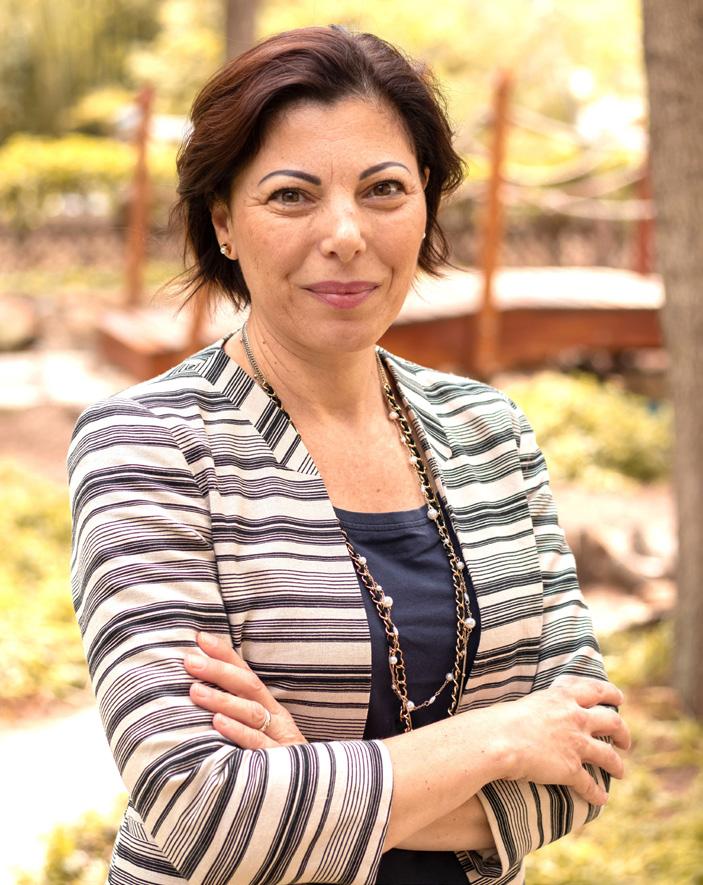
To conclude, what does the future hold for such schools of thought? In a fast-paced modern society where everything is instantaneous,
will the rise of AI and tools such as ChatGPT take over? Mangion is positive; good technology will always require creative strategy. But, moreover, the human connection will remain.
37 TECHMAG
Good technology will always require creative strategy, but the human connection will remain.

38 TECHMAG
DORA
A radical change in responsibility, compliance, and mindset for the financial services industry
The Digital Operational Resilience Act (DORA) and the Network and Information Security Directive 2 (NIS2) are two new pieces of European law that, coupled with the Cybersecurity Act and the soon-to-be-enacted Cyber Resilience Act, will fundamentally reshape the financial services industry. Dr Ian Gauci continues.
DORA has the potential of changing the financial services industry as the Act will compel licensed entities and their management, who retain ultimate responsibility, to fully comprehend how their IT systems function when it comes to operational resilience, cyber 3rd party, risk management practices, impact the resilience of their critical functions, and the development of operational resilience capabilities, which in some instances would also include advanced scenario testing methods.
DORA, which came into force on the 16th of January, 2023, will apply to the respective financial entities within 24 months from this date. Therefore, financial entities have a short
implementation period to comply with DORA. They should also be vigilant and follow the Regulatory Technical Standards (RTS), which may be implemented according to the same Act.
Before delving into some of the most salient points, it must be stressed that DORA has more to it than simply being the first harmonised operational resilience obligation in the financial services sector. Like the General Data Protection Regulation (GDPR), DORA introduces more accountability and an outcomebased approach to regulation. It also puts more responsibility on the higher management and board of directors of the organisation, as it pushes control to be responsible for
39 TECHMAG
POLICY
and assume that severe disruptions are unavoidable while simultaneously incentivising them to build a higher level of resilience to such disruptions in the operating model of their most essential services or functions.
What is DORA, and what does it capture? DORA forms part of the EU’s ‘Digital Finance Package’, aiming to develop a holistic European approach to digital finance that fosters technological development and ensures financial stability and consumer protection. The Act seeks to align national rules with operational resilience and cybersecurity regulation across the EU by establishing uniform requirements for the security of network and information systems of companies and organisations operating in the financial sector, which include:
Credit institutions
• Crypto-asset service providers
• Trade repositories
• Insurance, reinsurance and ancillary insurance intermediaries
• Administrators of critical benchmarks
Payment institutions
• Central securities depositories
• Managers of alternative investment funds and management companies
• Institutions for occupational retirement pensions
• Crowdfunding service providers
Electronic money institutions
• Central counterparties
• Data reporting service providers
• Credit rating agencies
Investment firms
• Trading venues
• Insurance and reinsurance undertakings
• Statutory auditors and audit firms
DORA will also target Critical ICT Third Party Service Providers, which provide services related to information technologies, such as cloud platforms and payment gateways, to financial entities, under the Act’s regulatory capture under a newly established Oversight Framework.
ICT Risk Management
In addition, DORA covers these areas of ICT risk management: Risk management, set up and maintenance of resilient ICT systems and tools to continuously identify and minimise ICT risk, set up protection and prevention measures, and establish dedicated comprehensive business continuity policies and disaster recovery plans. Incident reporting and the establishment and implementation of management processes that monitor, classify and report major ICT-related incidents as soon as they occur. This also includes reporting vulnerabilities to respective regulatory bodies, clients, counterparts and the public. Digital operational resilience testing and testing of the operational
resilience of capabilities/functions contained in the ICT risk management framework, which would consist of:
• Gap analysis
• Vulnerability assessments
• Scenario-based tests
• Compatibility testing
• Testing and analyses of performance on software solutions and source codes
• Penetration testing
• Network and physical security reviews to identify weaknesses, gaps, or shortcomings
• Periodic assessments, monitoring and documenting of ICT third-party risk, which covers, among other things, a coherent outsourcing policy and review of ICT third-party contracts.
Accountability and outcome-based approach. The compliance factor will undoubtedly require a shift in the mindset of financial institutions’ management and board of directors. They must be prepared for broader responsibilities, liabilities, and strategic implications when DORA is soon in full effect.
DORA shifts the current regulatory practice away from the ‘pure ex-post enforcement approach’ solely based on deterrence towards more of an ‘outcome-based approach’ that stems from organisational responsibility and accountability. The idea behind requiring companies to have internal compliance and accountability programs began in the US, where enforcement agencies could lower fines for organisations with compliance mechanisms during the late 1970s. However, the approach has also been embraced by enforcement authorities outside the US, like the Australian Competition & Consumer Commission’s
40 TECHMAG
DORA shifts the current regulatory practice [...] towards more of an ‘outcome-based approach’.
compliance objectives and France’s anti-corruption agency, which promotes good practices that include elements of accountability that may be taken in case of infringement into consideration. The UK also adopted this approach through its Bribery Act guidance notes, including principles aligned with organisational accountability and European regulations like the GDPR. The latter, aside from accountability, also embraces the ‘outcome-based approach’ as seen in Article 83.2, as it directs the Data Protection Authority to consider specific accountability measures when determining whether to impose an administrative fine and when deciding on the amount of a penalty.
To a certain extent, Article 51 of DORA could also cover some of the criteria in Article 83.2 of the GDPR. The principle of accountability under the Act is also coupled with direct responsibility. According to DORA, the managing body of the financial institution shall define, approve, oversee and be responsible for implementing all arrangements related to the ICT risk management framework. It shall also be empowered to have a practical control function. Financial institutions will also be responsible for managing the institution’s ICT risk.
The approach to be taken by managing bodies should focus on more than just ensuring the ICT systems’ resilience. Still, it should also cover people and processes through a set of policies which cultivate, at each corporate layer and for all staff members, a strong sense of awareness about cyber risks and a commitment to observe a strict ‘cyber-hygiene’ at all levels. The same management body would also need to have a specific plan and the required investments to actively keep up to date with
sufficient knowledge and skills to understand and assess ICT risk and its impact on the operations of the financial entity, including by following specific training regularly, proportional to the ICT risk being managed.
Financial institutions shall also ensure appropriate independence of such control functions to avoid conflicts of interest and ensure proper segregation and autonomy of ICT risk management, control, and internal audit functions. The financial entities’ management bodies should be required to maintain a pivotal and active role in steering and to adapt the ICT risk management framework and the overall digital operational resilience strategy.
When DORA affords a level of exemption and a simplified ICT risk management framework, financial institutions are still obliged to minimise risk and impact on ICT risks and have an ICT management policy, amongst others. However, DORA also moves towards a reality where the organisations and operators having regulatory capture will be required to do impact assessments to predict, contain and restrict any ICT incident.
The principle of the managing body’s ultimate responsibility for the management of ICT risks of the financial institution also goes hand-in-hand with the requirement to secure a degree of ICT–related investments and an overall budget for the financial institution that would enable said institution to achieve a high level of digital operational resilience. This obligation is not something to be taken lightly. For implementation, a financial entity will be required to integrate digital operational stability as a critical driver of its main business functions and decisions for its operating model. This results in directors and the management needing to comprehend the technology, business and risks of resilience capabilities and ICT risks related to its business. In addition, they must assess these risks pre-emptively and create a model to determine the required investment in resilience capabilities and also be able to articulate how these investments (or lack thereof) will cover impending ICT risks whilst also being extremely vigilant on how the respective regulatory authorities might interpret the efficacy and the proportionality principles under the same Act.
DORA will force financial institutions and their management to consider ICT-related risks as an active part of their existence. As reasonable and prudent operators, they should do their utmost to mitigate and reduce this risk. The Act, as an ‘outcome-based’ regulation, not only imposes specific obligations and processes (rule-based approach) but also focuses on principles and the results that the legislator aims to achieve and amplify upon (example through RTS) with the ultimate focus being the safety of the financial services industry, its members and users, and the prevention and mitigation of cyber threats.
One could also say that its foundational in the financial services realm, as it will transform business practices and the ICT compliance and mitigation cultures of the industry. However, some financial institutions’ transition will not be clear-cut.
41 TECHMAG
DORA will force financial institutions to consider ICT-related risks as an active part of their existence.
Why we need an ICT employment strategy

42 TECHMAG
ECONOMY
A lack of qualified ICT workers threatens Malta’s ability to meet demand and preserve its standing as a centre for top talent. To solve this problem, JP Fabri stresses the importance of a sectoral employment policy and collaboration between government, industry, and the education and training sectors.
Over the past few years, Malta has made promising technological advancements, and various efforts have been launched. However, in a post-COVID-19 world, the transition to a digital society must be more radical and holistic than previously imagined. This transition must be part of our economic recovery package, prioritising the creation of a digital community. This truly smart island moves away from just delivering public services online to becoming an island that is digital at its core.
A truly smart Malta, and not just as a slogan, is a Malta where people will be more empowered to live meaningful and fulfilled lives, enabled seamlessly by technology and offering exciting opportunities for all. It is where businesses can be more productive and

seize new opportunities in the digital economy. It is a nation that collaborates with our international partners to deliver digital solutions that benefit people and businesses worldwide. A smart Malta is integral to Malta’s next phase of nationbuilding.
Technology disruption is a global force we must confront and harness to our advantage. Developments in digital technology present opportunities for Malta to enhance our strengths, overcome our national challenges and physical limits, and build new sources of comparative advantage. Digitalisation will be pervasive and change life as we know it. Malta must embrace digitalisation and its benefits to prosper and stay relevant. In a smart Malta, we must move away from slogans to see proper
43 TECHMAG
transformation in critical domains, including government services, health, transport, urban solutions, finance, and education. Malta requires a holistic, mutually reinforcing strategy to build a digital economy, government, and society.
Strong system foundations must be in place. Cybersecurity must be the bedrock to secure all our digital efforts, protect users, and inspire trust in a technological future for our nation. In addition, we need robust and flexible data management systems and processes to ensure secure data sharing for policymaking, service delivery, and operations. Concurrently, we must also level up our people and culture to best capture this opportunity. Talent has always been Malta’s competitive advantage. Individuals must foster a mindset of lifelong learning to embrace change and strengthen their capabilities.
However, the broad ICT sector’s essential contribution to the Maltese economy in recent years and the contribution of ICT skills to other sectors of the economy have created momentum. This is reflected in a changed demand for high-level ICT skills in Malta, where homegrown supply needs to keep up with industry demand. As a result, the shortage is being filled by non-Maltese workers. It is also expected that the need for high-level ICT skillsets in the Maltese economy will, in the coming years, exceed the number generated by the current output from the education and training system and the numbers attracted through inward migration.
This level of demand is driven by the rapid growth in the technology sector and, crucially, the increasingly cross-sectoral nature of high-level ICT skills needs as digitalisation takes hold across all industries. This rapid growth in demand is accompanied by a tightening labour market in Malta and intense competition for high-level ICT talent internationally.
What will be required is a step change in Malta’s supply performance through a focused set of impactful actions that will underpin Malta’s continuing status
as a centre for high-end ICT talent. This ambition must be realised through a concerted partnership approach between the government, industry, and the education and training sectors.
Emerging technologies will impact Ireland’s high-level ICT skills market in the coming years, all driving fundamental change for businesses and consumers globally. These include diverse technologies such as artificial intelligence (AI) and cognitive systems, robotics, the internet of things, 3D printing, augmented reality and virtual reality, and next-generation security, all of which are enabled by the “Third Platform” of cloud, big data analytics, mobility, and social media.
Employers are reporting three significant challenges in the acquisition of highlevel ICT skills. Firstly, they are reporting difficulty in finding appropriate technical skills, particularly in new areas such as artificial intelligence, machine learning, blockchain, robotics, and specific software programmes in animation and gaming. The emerging nature of these skill sets means there needs to be more time for the education and training system to respond fully, and many of these skills are therefore being sourced from overseas. Now that the graduate student supply has improved, employers have also reported difficulties finding the right experience level. This is partly a legacy of the previous graduate shortages, as the most sought-after personnel are those with five or more years of experience. Many employers are engaging in the upskilling of existing staff to address this shortfall. Finally, difficulties are being reported in finding the right mix of skills: the most commonly sought is a combination of technical skills with communication skills, particularly those related to business acumen, to allow for effective communication with customers.
In the main, in the coming years, employers are expecting to hire a mix of graduates and personnel with more experience from other organisations. Support is also voiced for internships and an ICT apprenticeship model, which
44 TECHMAG
Malta requires a holistic, mutually reinforcing strategy to build a digital economy, government, and society.
is viewed as a welcome new entry into the ICT profession. In addition, more recruitment of expertise in new technologies such as artificial intelligence, machine learning, data analytics, and blockchain is anticipated. However, for most companies, the essential skills in computer engineering or electronic and electrical engineering will only change in line with industry trends, such as trends in programming languages.
Malta requires a specific sectoral employment policy for this critical sector that sets out to achieve a step-change in Malta’s supply performance through a focused set of impactful actions that will underpin Malta’s continuing status as a centre for high-level ICT talent.
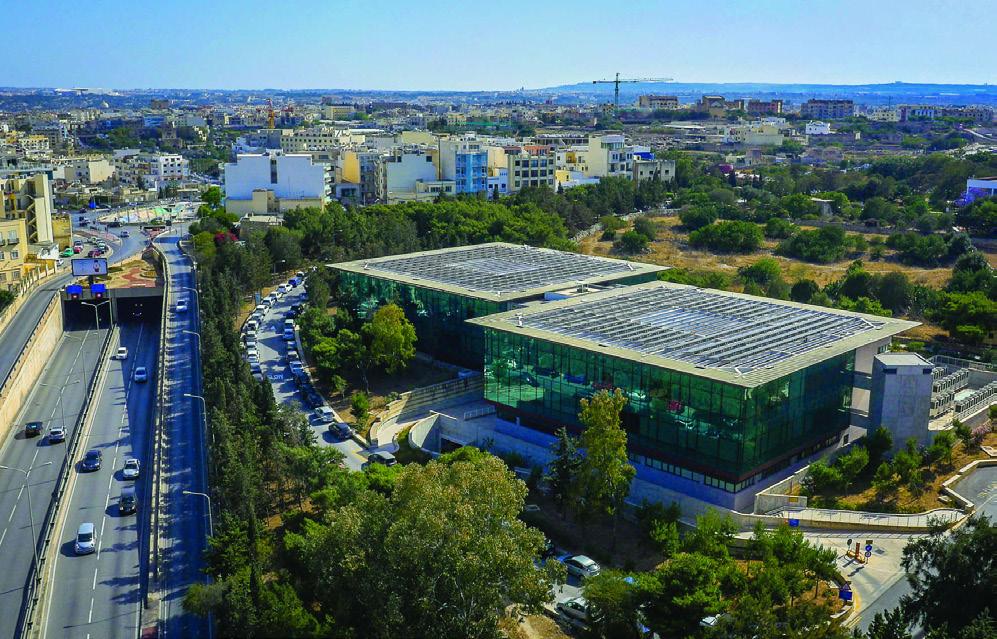
Meeting these skill needs will need to be delivered through three main strategic actions:
• expanding the numbers of ICT graduates, both through higher education academic pathways and
through new apprenticeship models;
• strengthening existing pathways and the creation of new structured opportunities for the development of high-level ICT skills through a progression from the further education and training system into higher education; and
• facilitating the inward migration of skilled ICT professionals from within and outside the EEA.
Such a sectoral employment policy should be the basis of a vision that sees Malta transform itself into a smart island whereby we truly realign and refocus on establishing a digital economy, a digital government that transitions into more than just online service delivery and transforms its culture and ethic, and a digital society whereby everyone is connected seamlessly through technology. This should be the strategy’s focus, and it must ensure that the foundations are built. Only then can we genuinely aspire to be a digital island.
45 TECHMAG
Such a sectoral employment policy should be the basis of a vision that sees Malta transform itself into a smart island...
The ICT faculty at University of Malta
HOW GOVERNMENTS CAN FOSTER GROWTH

Innovation is the key to a brighter future, but it does not happen by chance. Instead, it needs a public policy channelling significant public and private investment, a thriving business environment, and a national culture encouraging innovation, risk-taking, and cooperation. Theo Dix elaborates.
While most innovation comes from the private sector, governments worldwide have started to note their critical role in an innovation ecosystem. Governments can drive innovation by building the innovation agenda around frameworks that direct resources to where they are most needed, tackle specific societal problems, and deliver real results. For example, the UK government’s Industrial Strategy Challenge Fund aims to support the development of new technologies that can help solve some of the country’s most prominent social problems, such as clean growth, an ageing society, artificial intelligence, and future mobility. The fund is backed by £2.6 billion of public money and £3 billion in matched funding from the private sector.
Such approaches can generate significant payoffs. For example, when Israel had a severe water shortage, it put a lot of money into research and development
46 TECHMAG INNOVATION
in the water sector. This investment has led to the developing of cutting-edge technologies that allow Israel to recycle wastewater and turn saltwater into drinking water, building an economic cluster around an area where they faced significant challenges. As a result, Israel is now a global leader in water technology, with a thriving ecosystem of start-ups and established companies. Today, Israel exports over $2 billion annually in water technology and equipment and provides solutions to water scarcity in countries worldwide. The country has some 250 companies operating in the sector, including around 200 start-ups.
Another tool that governments can use to drive innovation in public procurement is by leveraging the state’s purchasing power. As a result, governments can encourage the development of innovative products and services. In recent years, governments have begun to adopt new approaches to procurement that prioritise innovation and risk-taking. One example of such an approach is NASA’s investment in private space companies. In 2016, NASA shifted its procurement strategy. It moved away from paying companies to build NASA-owned vehicles at NASA-owned facilities and instead paid companies to develop their cars and then buy flights on them. This move from traditional contracting processes to a service model saved taxpayers nearly $4 billion and, perhaps more importantly, helped the US secure 70% of the commercial launch market from 0% in 2012.
Start-ups are an important part of the ecosystem of innovation because they create new and disruptive ideas, many of which can have enormous benefits for society. One example of a start-up that has significantly impacted the industry is Corti, an AI app that detects people having heart attacks. The app uses machine learning to analyse calls to emergency services and see the signs of a heart attack, allowing emergency responders to provide the appropriate treatment more quickly. When a caller dials an emergency number, Corti automatically joins the call, analysing the conversation in real time. The system then gives real-time feedback to the person taking the call, letting them know about possible emergency symptoms or
situations needing immediate help. This helps the call handler make better decisions and provide more accurate advice to the caller. Corti has been tested in several emergency services across Europe, and initial results suggest that it can significantly improve the accuracy of emergency call triage. For example, one study found that Corti could correctly identify lifethreatening emergencies more than 90% of the time, while humans could only do it 73% of the time.
Investing in vital infrastructure like data and language tools is a must if you want to drive innovation. When governments open their data to the public, it can bring many advantages. First, entrepreneurs and researchers can use the data to start new businesses and find solutions to societal problems. For example, Transport for London (TfL) released data sets to the public, which led to the creation of the popular travel planning app Citymapper. This is an excellent example of how open data can lead to significant benefits. By letting developers use their transportation data, TfL allowed Citymapper to provide users with real-time transit information, such as updates on delays and service interruptions. This, in turn, has made it easier for millions of people to use the city’s complicated transportation system and combine different ways to get around, like public transportation, walking, and taxis, to get where they need to go quickly.
Natural language processing (NLP) technology is another critical area for investment in digital infrastructure. It deals with the interaction between computers and human languages, with various applications such as chatbots, virtual assistants, language translation, and generative AI tools. However, smaller countries like Malta face challenges developing NLP models for their national languages due to limited data and expertise, making it difficult to build language models and dictionaries to power the technology. Despite these challenges, investing in NLP research and development is crucial for driving innovation and can keep pace with what’s happening in other places. Moreover, it can be essential for the elderly, who may have difficulty using electronic devices, as NLP tools can enable them to communicate more easily with machines using their natural language and thus make technology accessible in a way that, to many, must seem unimaginable.
Innovation is the key to unlocking a better future. By focusing on significant societal challenges and investing in critical infrastructure, governments can unlock the potential of entrepreneurs and researchers, enabling them to create new businesses and solve pressing problems. The question is, are we ready to take up the challenge?
47 TECHMAG
The question is, are we ready to take up the challenge?
technology’s role in empowering ALS patients

48 TECHMAG
FOR GOOD
TECH
Dayna Camilleri Clark talks to Bjorn Formosa, the founder of Dar Bjorn and an ALS activist, about his experience using computer-assisted devices to communicate and control his living environment, the potential of brain-computer interface (BCI) technologies for unlocking new voices for locked-in patients, and his hopes for the future of AI and technology in creating a more sustainable and inclusive world.
How can technology assist ALS patients in their daily lives?
Let me start by saying that I wrote this interview using a computer-assisted device and my eyes. Since my diagnosis, I have lost control of all my muscles. I also experience speech difficulties. But through technology, I can continue to live a normal working life. A few years ago, I edited videos, created Photoshop images, and coded websites in seconds. Advanced software allows me to communicate again through my retinal movements.
Technology enables ALS patients to communicate alternately with the help of computer-assisted devices that turn eye movements into operative computer movements and vocalisation. By utilising an eye-gaze computer, individuals can regain their ability to converse cost-effectively and efficiently. With this device, ALS patients can use the Windows operating system through eye motions and even recover the power of their voice. Moreover, they can control their living environment with smart home alterations built into the said device.
Technology enables ALS patients to mainly communicate alternatively using a computer-assisted device that transforms eye movement into feasible computer movements and voice output. With an eye-gaze computer, patients can restore their communication abilities reasonably and efficiently. For example, patients can typically use a Windows operating system with eye movement and be able to speak again, even though they would have lost the ability to speak. They can also control their home environment through smart home adaptations installed on their eye gaze device.
How can technology assist ALS patients in communication?
Technology can assist ALS patients in communication by providing a new voice. ALS patients often lose their voice over time, but technology can help by
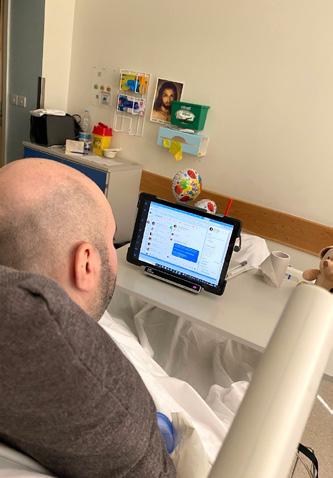
recording their voice and then using it to generate text or speech output. This can be done with specialised software installed on an AAC (augmentative and alternative communication) device. The device can then produce speech, using eye-gaze technology to track eye movements and select words or phrases. This can allow patients to communicate again, even when they cannot speak.
After eye-gaze technology, the next few years should spell the dawn of implantable brain-computer interface (BCI) technologies. The University of Wisconsin-Madison is developing an implantable brain-computer microelectrode interface for neurostimulation, while Synchron is working on an implantable brain device called Stentrode; how do you feel about this?
We are also working on BCI technology to develop a non-invasive device to read and translate brain signals into voice signals. This new technology for the future can allow locked-in patients to communicate even though they have lost the ability to do so. For example, if the patient is totally paralysed and can’t even speak, reading the brain signals with the help of a brain-computer interface will still allow them to talk. It can help them by providing, literarily, a new voice. ALS patients tend to use their voice for a long time, and technology can help in recording your voice in specialised software, using it, and installing it on communication software that, with eye-gaze technology, will allow you to speak again using an AAC device.
What challenges do patients face in using technology day to day? And is it affordable for all?
It’s no secret that the cost of cuttingedge technology can be prohibitively expensive for many people. Even as prices have come down in recent years, the high cost of new gadgets and gizmos can still be a barrier to entry for many consumers. But there’s hope on the horizon: as more and more people
49 TECHMAG
adopt new technologies, prices are likely to come down even further. And thankfully, there are also several foundations like ALS Malta+ that provide financial assistance to help people afford the technology they need.
Are staff at Dar Bjorn trained to provide support with tech needs?
We try to explain as much as possible about the new technology we’re using, even though we sometimes face barriers to its acceptance. We train our staff to be able to use and show the technology to patients who need it.
Was Dar Bjorn built with technology in mind? (And the second home?)
Yes, Dar Bjorn was built with technology in mind. The entire home is outfitted with smart devices that can be controlled via voice or mobile apps. Everything from the lights to the blinds can be automated, making it a truly tech-savvy home. Even the appliances are controlled by voice commands, making it one of the most technologically advanced homes on the market.

When Dar Bjorn was first built, the developers had technology in mind. They wanted to create a space that would be easy to control and maintain using modern tools and techniques. As a result, even public areas like the pool are designed with technology in mind, making it easy to keep clean and well-maintained. This allows residents to enjoy the amenities without worrying about being dirty or in disrepair.
What do you hope can arise in the future concerning AI and tech?
The future of artificial intelligence (AI) and technology is shrouded in potential but fraught with uncertainty. But despite the many unknowns about what lies ahead, I hope several things will arise from the continued development of these fields.
First and foremost, I hope that AI and technology will help us better
understand and care for our planet and all of its inhabitants. With ever-growing populations and increasing demands on limited resources, it is imperative that we find ways to manage our impact on the environment sustainably. AI and technology can help us do this by providing us with data and insights that we can use to make more informed decisions about how we live and operate.
Secondly, I hope AI and technology will help us create more inclusive societies
where everyone can participate fully and equally. Too often, marginalised groups are excluded from the benefits of advances in these fields, whether it’s because they need access to resources or because they need to be represented in the development process. By working to increase inclusion, we
50 TECHMAG
Through technology, I can continue to live a normal working life [...] Dar Bjorn was built with technology in mind.
can ensure that everyone can benefit from the tremendous potential of AI and technology.
Finally, I hope that AI and technology
will help us realise our full potential as individuals and species. We have only scratched the surface of what these fields can do for us, and I believe that there is so much more yet to be discovered. With continued exploration and innovation, who knows what we might achieve?


Help make a difference at ALS Malta by sending an SMS donation at 5061 8936, €6.99, or 5061 9271, €11.65, or by visiting darbjorn.com/donate.

51 TECHMAG

How did your journey into becoming an athlete unfold?
When I was younger, I always thought of myself as someone who could not be athletic because of my disability—I was born with talipes equinovarus. However, my mindset changed once after a class race, where I placed third. This proved that despite my disability, I could still be an athlete.

Fast forward a few years, and in 2021 I had some great news: I was selected to represent Malta in the Tokyo Paralympics. Representing our country in the 2008 Beijing Paralympics was my big dream.
Unfortunately, I could not participate in last year’s games due to an Achilles tendon rupture months before. For this reason, I decided to forfeit my place to another athlete.
When did you take up running?
I started running in 2004, a few months after the class race I mentioned. The idea that I could be an athlete grew with each passing day. I did a lot of research on the local running scene. I emailed several notable athletes, one of them back with a club’s contact details- the rest is history!
What do you enjoy most about being a professional sportsperson?
The best part of being a semi-professional athlete is knowing I am doing my utmost to hone my craft. I am not simply practising the sport for fun but seeing how far I
can go and continue pushing myself.
Can you share with us your relationship with technology?
Technology is essential to my life. Without prosthetic technology, I could not live my full life now. First, a comfortable daily prosthesis allows me to live as much of my everyday life as possible without missing out on things and with minimal discomfort. Then the state-of-the-art, high-performance running blades enable me to practice and perform as close to nondisabled athletes as possible.
What do you think the future holds concerning tech?
We are at an age where science and technology are progressing exponentially. During my lifetime, I might see prosthetics advance so much that these could rival and even surpass human body parts.
What are some of your top career highlights to date?
The two highlights of my career thus far are competing in the 2008 Paralympic Games and when I was able to equal and eventually surpass my pre-amputation personal bests.
What is the most challenging aspect of professional sport for you?
The most challenging aspect is that you do not always feel great physically or mentally. This is because you have to train even when you are not a 100%. It is just like work; you must put in the weekly
hours. Another challenging aspect is the injuries you may face. When you are injured, you must alter your training programme and allow your body to heal. This is very difficult to handle emotionally, as it feels that all the hard work you have done in the past months to improve your performance will be lost.
How do you stay motivated?
I stay motivated by keeping realistic goals and then trying to achieve them. Goals can be both long-term and short-term (usually, short-term goals are simple, such as planning to handle a session I could not do in the past). I am also a total anime geek, and I get a lot of motivation from this art form. Most anime I enjoy watching involves a protagonist facing a seemingly impossible trial, and through hard work and resilience, it is overcome.
How do you balance elite sport with the rest of your life?
Balancing your life is all about priorities. I want to spend four hours gaming daily, but unfortunately, some things must be sacrificed. I always make time for the essential things in my life, such as family, work, and sports. We all have the same number of hours in the day; how you use them differs from person to person.
What advice would you give to other aspiring athletes?
My advice is to simply take the first step. It may seem complicated and even scary. You might not be great at the beginning (you might even be terrible, and that’s ok),
But with consistency, you will improve. Once you start, you will make minor, almost unnoticeable improvements, but once you look back months after you have created, you will be amazed at how far you’ve come.
How is 2023 shaping up for you?
This year is shaping up well so far. In 2021 I endured that horrible sports injury (ruptured Achilles tendon during a qualifying attempt for Tokyo Paralympics), and 2022 was a reintroduction to intensive training. Because of this, I can train hard this year and try to beat my personal bests. In addition, I aim to qualify for the world paraathletic championships, which will be held in Paris. This will be a warm-up event for next year’s Paralympic games.
You can follow Antonio’s journey at www.facebook.com/ antoniofloresmalta.
53 TECHMAG
Start-ups to watch out for in 2023
It has become a dream-turned-reality for many to stray away from the typical 9–5 office job and set up something they can call their own. As a result, Malta’s tech sector is booming, with many start-ups expanding in this field.
Techmag compiled a list of the best Malta start-ups to watch out for: an eclectic mix of hyper-growth scale-ups, small creative businesses, and everything in between. We asked them a few questions to get to know them and their start-up venture better.
54 TECHMAG
Ben Vincenti
Co-founder & COO, Tableo.com
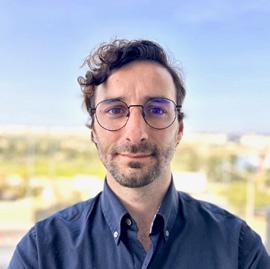
hit, and we went from having the best quarter in our history to trying to keep everyone’s job. Despite this, we did not back down. On the contrary, we used this as an opportunity to reinvent ourselves and create two thriving and fastgrowing platforms: Bookia and Tableo.
Definitely surviving COVID-19 and launching two flagship, thriving products. We’re also proud that we managed to expand Tableo into foreign markets, namely Spain and Italy. Becoming Reserve with Google partners and becoming Michelin partners are recent highlights of our journey.
Describe your company in three sentences.
Get Hitched Inc. Ltd. runs Bookia, which helps people find and book restaurants, and Tableo, which allows restaurants to manage their reservations. Through Bookia, we make it easy for diners to find and book restaurants. We also help restaurants get more bookings, which means they make more money. At the time of this writing, 168,303 diners have booked through Bookia.
Through Tableo, we help restaurants get organised, save time, automate bookings through any online booking channel, turn more tables, reduce no-shows, collect payments, and more. At this time, Tableo has processed bookings for over 1,828,782 diners.

We work with 500+ restaurants across Europe and are currently working on further international expansion. For example, Tableo is used by restaurants in Malta, Spain, and Italy. We are also running a pilot of Bookia.cy in Cyprus.
What makes you different?
Resilience: Our company started with two flagship platforms, gethitched.eu and evently.eu, offering wedding and event service finding. We doubled our growth year-on-year—until the pandemic
Self-awareness and honesty: We are very self-aware and self-critical. We know what we’re good at and what we need to get better at. We’re completely honest with ourselves, our employees, and our customers. We’re transparent in all communications, both when things are going well and when they could be better.
Active listening: We listen to what our customers want. I believe a big part of the success of our platforms comes down to the fact that they are built around what our users and customers want. So we aren’t just good listeners; we are also proactive and put in a lot of effort getting feedback from our customers.
Agility and speed of execution: We are super-fast in building and bringing products to market. Indeed, Bookia and Tableo are perfect examples of this, where we went from zero to launching two new platforms with 500+ paying customers across Malta, Spain, and Italy and processing over 500,000 reservations in under two years. Moreover, in this short period, we have developed a robust feature set that many of the competitors that have been in the market for many more years than us don’t have, such as the interactive floor map, automated voucher system, reservation with Google integration, Michelin Guide integration, Trip Advisor integration, as well as the Facebook and Instagram integrations.
What have been your biggest wins to date?
What type of people are you trying to attract with your product?
We first want to attract Bookia diners—anyone who likes to dine out and wants a seamless experience when discovering and booking restaurants. Next up, we want to encourage Bookia restaurants—restaurants looking to get more exposure, more bookings, and more revenue. Lastly, Tableo restaurants: restaurateurs who wish to leap to digitise their reservation management processes, allowing them to gain efficiencies and take their restaurant to the next level, as well as restaurateurs who are looking to get more exposure, more bookings, and more revenue.
What are your long-term plans and goals for your company?
Our long-term goal is simple: we want to expand our product offerings internationally, whereby our brands will be recognised as global brands in their own right. We want to achieve this by remaining true to our values and continuing to generate value for our users, customers, employees, and company.
55 TECHMAG
Tiziana Ellul Founder, Bettiwears.com

clothes. The business was created to help the community take better care of the planet by changing consumption habits.
What makes you different?
The personalised and ease of service that we offer our customers, together with the variety and condition our items are in.
What have been your biggest wins to date?
Describe your company in three sentences.
Our primary mission is to inspire people to fall in love with pre-
Our most significant and unexpected win was that we were nominated for the Malta Business Awards in the “Start-Up Business of the Year” category organised by the Malta Chamber of SMEs. Another win for us is having people who never dreamed of buying
so. Also, women would love to buy a fashion item that they can’t afford to buy brand new. At Bettiwears, one can find various fashion items, from clothes to shoes, bags, and accessories. Sizes range from UK size 4 to UK size 20. Bettiwears supplies pre-loved fashion items from popular mass-market brands (fast fashion and high street), premium brands, and accessible luxury to supreme luxury. Our ultimate goal is to attract women who understand that owning pre-owned items is admirable, righteous, and ethical.
What are your long-term plans and goals for your company?
Bettiwears is still in its early stages since we haven’t even been in operation for one year. Although we have already achieved a lot in the past few months, we want to focus on more exclusive pieces in our collection and create more awareness and education on why one should opt for pre-owned items before looking for new ones. There is no shame in owning preloved items.
owned fashion and our planet.
Bettiwears is Malta’s first online pre-loved fashion store, where we allow women to buy good-quality clothes at more affordable prices without compromising on quality. This consumption behaviour, in turn, extends the life cycle of the

pre-owned items buy from us and become repeat customers.
What type of people are you trying to attract with your product?
Women who want to look and feel good without breaking the bank do
We do have other exciting plans for the future, which we cannot disclose for now. However, we recommend people stay tuned to our social media to stay up-to-date about what Bettiwears will be up to in the near-to-long term.

56 TECHMAG
David Sakic
Co-founder & CEO, Braintrip.net
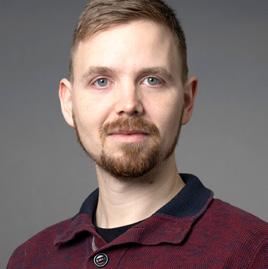
where hundreds of neuroscience experts listened to our presentation. In September 2022, we officially entered the market, meaning that the BDI test became a commercially available screening test for dementia.
What type of people are you trying to attract with your product?
be wrong. We are also looking for franchise partners that could help us open more BDI Centers.
What are your long-term plans and goals for your company?
Dementia screening is only the first step. Next, we will up-classify the BDI, meaning that it will become a fully-fledged diagnostic test for dementia. In the upcoming
Describe your company in three sentences.
BrainTrip is an applied neuroscience start-up that has developed a scalable solution for early dementia detection. The BrainTrip Dementia Index (BDI) takes in brainwave (EEG) data. It returns a number from 0 to 100— the lower the score, the higher the chances that the person being tested suffers from dementia. The BDI can decrease the time to dementia diagnosis by several years.
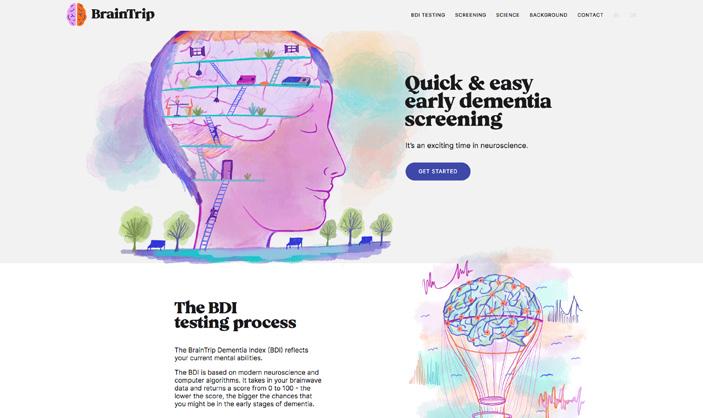
What makes you different?
From the beginning, we’ve been building the BDI so it can be used anywhere in the world. Other dementia-screening solutions are either stationary or need to be performed by highly trained personnel. The BDI system, on the other hand, fits in a small suitcase and can easily be used in rural areas that generally don’t have access to high-tech solutions.
What have been your biggest wins to date?
BrainTrip was one of the few companies worldwide (and the only Maltese company) that received the Expo 2020 grant. We did extensive scientific research to validate the BDI. We were invited to present our findings at the prestigious Society for Neuroscience conference,
The BDI test is meant for people over 50 who are worried about their cognitive health. If used regularly (e.g., once per year), the BDI can reliably track mental health over time and serve as a first warning sign that something might
years, we will develop EEG-based biomarkers for other hard-to-detect and diagnose brain disorders. Depression, anxiety, and ADHD are just a few diseases that currently lack a reliable, quantifiable way of detection.
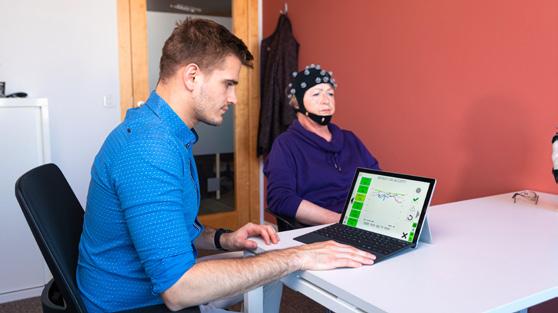
57 TECHMAG
Ricky GaleA CEO, Trustedtutors.com

connect students with the tutor they feel comfortable with— making sure that they “click.”
Understanding the hecticness and costliness of today’s world for parents, we facilitate and coordinate lessons around their schedules and offer discounts for multiple subjects and siblings. Students can come just for classes, past paper revision, a crash course, etc., without necessarily being committed to a 9-month ‘privat’ programme.
What have been your biggest wins to date?
decide what to study and what career to pursue is very rewarding because we can help shape people’s lives. Regarding business achievements, we can mention quite a few: widely recognised companies reaching out to us for partnerships and requesting tailored corporate training from us, being trusted with the children of many leading figures, and being hand-picked by some of the largest international tutoring institutes for collaborations.
Describe your company in three sentences.
Trusted Tutors is a one-stop tutoring platform that connects students to tutors they can trust. We offer private tuition for all subjects at all levels—academic and non-academic, leading up to an exam or just learning for fun. Our tutors accommodate whatever request is made, tailoring our services around the student’s needs, including one-to-one or small group tutoring, online, in-person (physical), or home tutoring.

As cliche as it may sound, the biggest wins for us are when we see students with specific problems—
What type of people are you trying to attract with your product?
We believe that education should be accessible to anyone; hence, the services we offer are on the market for any person, be it an independent, mature person wanting to take their O-levels; a parent struggling to juggle with all her kids’ commitments; an adult seeking to learn a new language for fun or to move to a new country or to learn a new instrument; foreigners and ex-pats wanting to learn or improve their English and Maltese; companies requiring specifically tailored training for their employees; or university students asking for assistance and guidance with some particular module, assignment, thesis, or dissertation. Of course, we offer more than just tutoring for teens taking their primary exams, O-levels, or A-levels in the main subjects, which is where most of our business comes from.
What are your long-term plans and goals for your company?
What makes you different?
We genuinely believe that the chemistry between a student and a tutor can make a difference in a person’s passion, performance, self-esteem, career, and other life choices. Hence, we strive to
like low self-esteem from bad grades, not knowing how to deal with a newly diagnosed need, or problems with their families— thrive and improve in all areas with the help of our dedicated tutors. Also, helping students
Being the household brand that serves as an efficient tutoring platform where anyone can learn anything. As we strive to grow, we aim to establish partnerships with numerous academic and business institutions. We see ourselves as becoming a pillar in proposing and facilitating the implementation of policies in the education sphere.

58 TECHMAG
Anna Horvath
Founder & creative director, Sorgi.mt
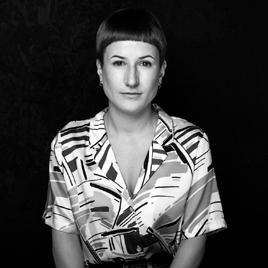
time buyers with multipurpose use in small spaces. I create visitor experiences and tell stories that can fold through a hotel or restaurant interior, set design, retail environment, or public space. I also believe my playful visual aesthetics can differentiate AHA from other studios.
What have been your biggest wins to date?
Describe your company in three sentences.
AHA Object is an emerging design studio based on storytelling, sustainability, and joy. AHA provides a multidisciplinary design approach for its clients, including interior design, furniture design, product development, and creative direction. The studio develops products and collections through sustainable development in collaboration with the best professionals, suppliers, and artisans. Malta-based AHA Object is where designs merit inspiration from local aesthetics and craftsmanship, with numerous international projects, sales, and collaborations.


What makes you different?
Firstly, the island has some great architecture and interior design studios, which I greatly respect (most of them are my friends and collaborators). On the other hand, I believe that my work is unique due to its concept-driven character. All collections are born with an initial aim: to solve a problem or deliver a brand message. With my latest collection, SORĠI, I aim to find creative solutions for the increasing construction waste. With my following collection (in collaboration with a local furniture manufacturer), we are creating feasible domestic objects for first-
SORI’s inception: the start-up recycles construction waste and converts marble off-cuts from suppliers into outdoor furniture and art installations. The project started two years ago with the support of the Arts Council Malta, which turned into a wild adventure of making heavy pieces and hasn’t stopped since then. I went through many phases with the start-up, from prototyping to introducing the concept internationally, participating in accelerator programs, and creating a business. It taught me about so many amazing people. Nonetheless, it stretched me physically, financially, and mentally, but I still love it!
What type of people are you trying to attract with your product?
I collaborate with architects and design studios. Furthermore, my clientele includes property developers and cultural, educational, and financial institutions. I develop furniture collections for banks, schools, museums, and retail stores. Generally, my objects are for public buildings and public spaces used by the community. It can serve as a city-branding tool and turn unknown locations into destinations.
What are your long-term plans and goals for your company?
I will continue to work on projects locally and internationally, individually and in collaboration. I envision AHA Objects with
multiple collections, finding ways to recycle different types of waste such as construction, sea plastics, etc. I am always interested in discovering new craftsmanship and technologies; therefore, collaborating with suppliers and manufacturers and putting new lines of products on the market is my goal for the future. Furthermore, I will keep designing interiors, sets, and custom-made furniture elements. Unfortunately, construction waste is a universal issue. Therefore, SORĠI has the potential to be established in several locations around Europe or the world. It doesn’t matter whether construction waste affects newly raised financial districts or wars; the start-up can develop public seating for both circumstances.
59 TECHMAG
Renato Barati Founder, Deliwee.com
What makes you different?
Describe your company in three sentences.
Deliwee is a food ordering system and delivery service provider that helps local restaurants establish a professional and profitable way of attracting, handling, and fulfilling delivery orders, table bookings, and other in-house services/operations. Our solution gives restaurants the control and benefits of an in-house ordering and delivery system while giving customers the convenience and flexibility they want today. Our mission is to allow customers a fast and seamless trip to their choice of restaurant without leaving their homes. Our vision is to support the growth of the local economy by connecting the restaurants to the local community by providing a cost-efficient and timely food delivery service that connects both ends directly, with no “middle man” involved.
Our innovative approach to the industry sets us apart from our competitors. We are not just an application; indeed, no app installation is needed. Accessible from any device, at any time, for any given time, customers can order food from their favourite local eateries and shops through our platform. Furthermore, we partner with professional, carefully selected, and trained drivers to offer increased efficiency, complete control over fulfilment, and the lowest rates to fulfil delivery orders for restaurant partners on the island. As a result, our customers are not charged any additional order, platform, or service fees like all other known companies. Also, our delivery fees are often less than those of our competitors when compared to the exact distances.
What have been your biggest wins to date?
Our most significant achievement to date has been partnering with a renowned international online ordering system for restaurants. They recognised us as a trusted delivery service provider and offered us visibility on their platforms, allowing new vendors to choose us by default. This partnership was made possible due to our successful completion of a partner integration with their software. Today, we are a trusted partner of this company, which operates in over 150 countries with more than 22,000 active restaurant partners.
Other significant wins have been the rapid adoption of our solution by local restaurants and customers. In less than a year of operation, we have partnered with over 30 restaurants on the island and provided food delivery services to thousands of customers. In addition, we have received positive feedback from restaurant partners and customers, which helps us

slowly build a strong reputation in the industry.
What type of people are you trying to attract with your product?

At Deliwee, we focus on attracting conscious and aware consumers committed to supporting their favourite eateries more sustainably and profitably. We believe in creating a community of customers willing to put in the effort to order directly from their favourite restaurants or look for alternatives rather than using available platforms that take a large percentage of the restaurant’s profits. Our target audience is customers interested in convenience who understand the value of supporting local businesses and want to participate in a movement that empowers and boosts their favourite restaurants’ profitability. By engaging with us, our customers can positively impact the local economy while enjoying the convenience and flexibility of online food ordering and delivery.
What are your long-term plans and goals for your company?
In addition to investing in technology to improve our platform and services, we have a unique and unmatched idea that we plan to bring to life and introduce to the market for the first time by us. Our long-term goal is to expand our reach to more cities and countries while continuing to prioritise sustainability and profitability. Furthermore, we aim to establish ourselves as the go-to platform for conscious consumers who value supporting their favourite eateries directly. We will work tirelessly to make our user experience more user-friendly and intuitive. Ultimately, our goal is to revolutionise how people order food online and help build a more sustainable and equitable future for the restaurant industry.
60 TECHMAG
...worthy of mention
Abe Health: Abe Health is an exciting company that provides academic assistance to nutritionists, trainers, and coaches by applying the latest academic knowledge in life sciences to clients’ data, giving them personalised and actionable advice. This helps professionals in the well-being industry to scale their reach while lowering the time spent on each client and maximising their clients’ health span. Founded in 2021, Abe Health is located in Qawra. abe-health.com
Binderr: Founded in 2020, Binderr is a pioneering start-up in the emerging corporate technology field, working to transform digital corporate services across the European Union. The young company is focused on simplifying the process of incorporating and making corporate changes across Europe, emphasising ensuring regulatory compliance. Binderr recognises the shortcomings of current solutions that are often ineffective, complicated, and not tailored to the needs of modern businesses. Its operations are based in Sliema, and it has raised €2 million so far. binderr.com
Fyorin: Based in Birkirkara, Fyorin offers a payment and financial operations platform that helps finance teams who work with multiple financial providers that


are not integrated. The innovative platform automates receivables, monetises funds flow, and provides various features that simplify financial operations, including multi-currency bank accounts, virtual cards, and direct accounting integration. Founded in 2019, it has been able to secure €650k. fyorin.com
Metaverse Architects: Founded in 2020, this architectural firm specialises in designing and developing for the metaverse, helping brands come to life in virtual worlds like Decentraland and Somnium. They help clients get a return on their investment in the metaverse by building things like NFT galleries and crypto casinos with a team of passionate game developers and architects. In 2022, Metaverse Architects raised an undisclosed funding round. metaverse-architects.com

Woowbe: Founded in 2020, WOOWBE is a loyalty channel that
provides businesses with a digital platform for card-linked offers and cash-back rewards. It’s a simple and innovative solution that helps companies achieve greater brand loyalty without requiring operational changes. Users can link their cards to receive rewards quickly and securely, making it a hassle-free way to earn rewards. Woowbe is based in St Julian’s. woowbe.com

61 TECHMAG
Emerging talent requires hard truths to grow

62 TECHMAG
START-UPS
Surrounding yourself with people with great knowledge and experience who have a strong mind and are willing to help you achieve the seemingly impossible is a good recipe for success. However, asking a start-up founder to go from an idea, a concept, and a prototype to becoming a global market leader in their industry or an internationally recognised commercial brand is a big ask. Adrian Galea explains.
Yet we seem to liberally encourage people to take on the entrepreneur mantra without providing them with an environment fraught with talent to enable them to grow. The hard truth is that in an ecosystem like Malta’s, where early-stage start-ups are a new phenomenon, few people have genuinely been through a successful founder journey. Finding the right advisor will prove invaluable to a start-up founder.
What gives entrepreneurs hope and inspiration is that when they successfully exit a previous project, they are more likely to stay involved and give back to the ecosystem that helped them succeed. In Malta, we have seen early examples of this, where GFI technologists inspired the founders of early Malta-based start-ups like Altaro and Hotjar. Now that these have earned success, their founders actively seek to support the next generation of Malta-connected start-ups. Add to the mix the broader financial services sector, which attracts high net-worth individuals from multiple spheres who use Malta as a headquarters for their investment companies and projects, as well as the attractive grants offered by various local entities, and you have the makings of a network wherein both chance meetings and strategic encounters can take place to form the foundations for new international grade start-ups to emerge, guided by experienced advisors.
First-time founders, or rather start-up entrepreneurs who have never been involved in a worldclass organisation, have little chance of achieving such scale and success. Being a start-up founder often feels like there are too many variables, nothing is within your control, and the expectations on your shoulders might swallow you up at any moment. Founders rarely possess all the know-how, don’t have the network, and lack the proper access. Simply put, they need to surround themselves with individuals who have earned the scars and emerged victorious against all the early-stage odds. One can be forgiven for believing that the return on investment from attracting such individuals to your start-up is derived from the signal
it portrays to the outside market of your ability to recruit top talent. Yet, able start-up founders go far beyond this and embrace the presence of such talent as great advisors. These individuals can provide founders with direction and decision-making tools when every other option available to them fails to work. Recruiting the advisors is just the first step. Learning how to tap into their superpowers as introducers, ambassadors, consultants, and mentors is what separates the good from the great. Furthermore, recruiting a well-known figure from the space you’re working in can open some doors and be attractive to other people who want to get involved or invest so they can get next to your advisor.
63 TECHMAG
“We’d probably have crashed and burned years ago without our advisors. They all helped, but one in particular, Michael Ganser, a former Cisco CEO, probably had the biggest impact. Not through any single piece of advice - but by having someone super experienced for us to go to before taking any big decisions, especially in the tough times. Eternally grateful.”
— Max Thake, peaq co-founder
Surprisingly, but only for those who dare, such advisors are not as inaccessible as budding founders may initially think. Many first-time founders are reticent to reach out cold to other CEOs or people they deem too accomplished or famous. The trick is in aligning the interests of the parties involved. Whereas financial compensation is a factor here, it’s not what I mean. Entrepreneurs are lifelong learners, and successful entrepreneurs love having access to the latest and most daring technologies and business models. Successful
solve a specific problem at the right time. Recruiting the right person as an advisor should be one of the first validation points not only of your business but, probably more importantly, of your ability as a company leader and motivator. After all, most of the people you will seek out as advisors were there not too long ago. They will be more empathetic than most to your situation.
Here is where culture and the mindset of the players involved take a central role. Unfortunately, I
for the task at hand. A lot depends on the market concerned and the scale of the business. If you are scaling fast and have specific challenges, bringing experience
entrepreneurs are infected with the bug, even after their start-up journey has been completed. This means early-stage founders owe it to themselves to seek influential advisors; luckily for them, the main ingredient is the start-up they have on offer. Successful entrepreneurs are probably wealthy. Money and networking are not what they want from you. They ask for a compelling start-up story, an intelligent product, and an exciting founding team to back them. Great power comes from connecting the right person with the right company to
have often learned of start-ups that had mishaps with advisors simply because they built the relationship upon transactional motivations. A typical storyline is that the founder encounters a problem they have never faced before, for example, partnering with a supplier in Asia. They hire an advisor their lawyer cousin recommends, which ends in tears and money down the drain, and a sham advisor chasing the poor entrepreneur for compensation. The onus here is on the start-up founders to show skill in identifying the right advisor
on board is invaluable. Similarly, if you are entering a specific space, you don’t know it’s a great idea to use external help, and yes, it may prove expensive at times. Another critical aspect is finding advisors that understand the uniqueness of operating within a start-up context.
The form of the relationship can vary. I would advise caution in the beginning, and the first interactions should be about nothing more than relationship building and simply discussing the future goals and milestones of the start-up. Think

64 TECHMAG
Start-up advisors don’t always need to be right, but they have to be solid.[2]
of friendship first and assistance later. I would also advise against discussing compensation until you are a couple of interactions into the relationship already. Prospective advisors should first consider whether they believe in the entrepreneur and their vision for the company.
With some advisors, the relationship may be purely functional and short-term, for example, getting advice for a trademark or patent application. With others, the relationship may be more strategic. Strategic advisors are distinct from members of the board of directors. Although the latter has legal ramifications attached to the relationship, advisor agreements can be flexible and constantly renewable. A typical start-up advisor who is of ongoing strategic value to the founders (using the US model) can expect to receive somewhere around 0.1%1% in start-up equity, on top of any one-off compensation from specific operational projects they may be involved with. You should enable the equity through vesting periods
to ensure value is earned over time. Should the relationship end prematurely, as it often does, there is a legal mechanism to adjust the compensation accordingly. Be careful not to assemble members for an advisory board[1] (or group of advisors) who are too similar either to you and your start-up team or to each other (i.e., functioning as a deeply homogeneous group that lacks diversity in abilities, knowledge, and connections).
Here is what the profile of an attractive advisor for your start-up could look like:
• They are a domain expert in an area critical to your company over the next 12–18 months, and they’re well-connected to a class of people you’re trying to reach.

• They possess the ability to apply lessons and logic to different, flexible problem sets. They are problem solvers.
• They are a person whose values match or complement your own, whether these are social or impact-driven or of the go big or go home mentality.
• Aim for low ego. You’re looking for brilliance and expertise here, but the key to a valuable advisory relationship is that person’s willingness to make time for you, not them.
If they’ve bought into you and your story, the great ones will gladly engage during the initial period without asking for anything
in return. They will be highly responsive and helpful on the key hard questions. They will be able and willing to share knowledge and learning without insisting that their experience marks the obvious right path for your company.
The final point about advisors is that they will often provide the advice you do not want to hear because you are very connected to your start-up and thus do not see the bigger picture. It would help if you had guidance from people who aren’t afraid to unpack their instincts. While advisors might not always be right, their more neutral perspective and experience often mean that their advice is usually sound. Thus, it would be best if you were looking to take it on board, at least give it lengthy consideration. This process of collaboration and debate brings out the founder’s and the business’s best and most valuable attributes. Because of this, I believe the most valuable advisors deliver clarity of thought and structured arguments through empathetic and meaningful discussion. Interactions will encourage you, and your advisor will be fun to spend time with.
[1] www.medium.com/swlh/acomplete-guide-to-startup-advisorsand-mentors-5d5704dc7e84
[2] www.firstround.medium.com/ dear-startup-advisors-you-don-talways-need-to-be-right-but-youhave-to-be-solid-75652c863566
65 TECHMAG
How can a Web 2.0 company include Web 3.0 in its strategy?
You have probably already heard of Web 3.0. Well, the topic is getting trendier every minute. Perhaps it was during a conversation over a coffee break at the office, during a TV debate, maybe after a monkey JPEG was sold for $500k or when Bitcoin was booming? Was it because the market was falling and speculating about a potential bubble? Alexandre Hardouin asks.
Regardless of the reason, one thing is obvious: Web 3.0 and the blockchain are making quite a buzz. However, more than just the public, it seems that numerous traditional web2 brands are willing to take the leap and step into it.
What exactly is Web 3.0?
What is Web 1.0?
The first version of the internet, from 1991 to roughly 2004, broadcasted information but strictly read-only, statically and with very little interaction.
What is Web 2.0?
Nowadays, popular internet. The one of sharing, social networking and commenting. The interactive internet allows everyone to give their opinion, create content, and exchange with the whole world via their computer. Web 2.0 was the first revolution, and today most business revolves around it: LinkedIn is the number 1 solution for finding a job and networking, Instagram is the number 1 solution for art, and Twitter is the number 1 solution for sharing information. Web 2.0 is mainly driven by data collection and processing. This is how algorithms work to provide personalised content. Web 2.0 is the web of data over which the consumer has no control or rights. Corporations control all data. The same goes for any digital asset: pictures, accounts, currencies, blogs, 3D
models, video games, bonds, and stock. Corporations control everything and can be seized at any moment è This is a centralised ecosystem.
What is Web 3.0?
The most crucial difference between Web 2.0 and Web 3.0 is the integration of blockchain and, thus, decentralisation and ownership. As far as decentralisation is concerned, this means that instead of companies holding all your data, each website owner will have a Web 3.0 wallet that stores all their data. But the real revolution is removing the intermediary and the ownership of digital assets because this wallet will store your data and all your digital assets. You are now the sole owner of this data. In one
sentence, Web 3.0 is simply an interacting internet where you can own digital assets called tokens. They can either be fungible (cryptocurrencies) or non-fungible (NFTs).
What impact on consumers?
Instead of answering the question: what are the opportunities for Web 2.0 corporations? Let’s try to put the question from a different perspective. To make a genuine impact, a company should provide a product or a service that fulfils a legitimate need. Thus, what are the opportunities of Web 3.0 for consumers?
Decentralised Finance - Finance 2.0
DeFi is an acronym for decentralised finance. It is an emerging technology
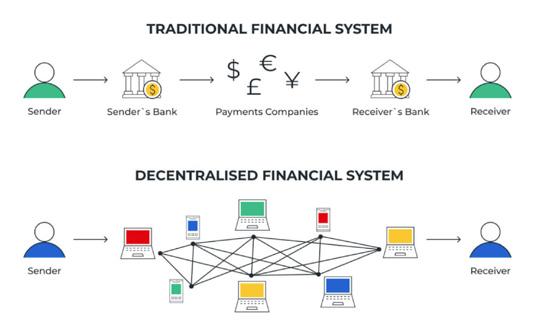
66 TECHMAG
METAVERSE
that recreates financial services with blockchain technologies. Like conventional banking, DeFi allows users to perform financial transactions, such as transfers, lending, investing, trading or savings. However, DeFi allows consumers access to these financial facilities without an intermediary entity. No brokerage, exchange, or financial institution is involved in the DeFi ecosystem. This allows DeFi’s application to go beyond conventional boundaries, making it accessible across markets, regions, and different layers of society.
Hence, every financial service can be rebuilt and redesigned with DeFi for better accessibility, efficiency and innovation. Explosive growth creates opportunities for start-ups. As DeFi continues to grow, it is upon enthusiasts and developers to figure out how they can create space for themselves in the metaverse. However, one sure thing, being a simple intermediary, will soon no longer be enough. Having exact and concrete added value will be an essential—exciting times.
The NFT: the property title
A non-fungible token (NFT) is a unique digital asset identifier that cannot be copied, substituted, or subdivided, recorded in a blockchain, and used to certify authenticity and ownership. Opportunities are infinite.
Here are a few of them, classified by industry:
The luxury industry
An NFT is a digital asset registered in the blockchain. As such, we have a seamless track record of its entire existence. For example, let’s imagine you were to purchase a second-hand Rolex or Chanel bag. Of course, you could be lied to with fake certificates and buy a fake product. But if Rolex issued an NFT at the original sale, you can now request the NFT at the same time as the watch purchase, giving you an authentic certificate and the history of Rolex’s purchases.
The art industry
NFTs will disrupt the art industry. For one thing, it will enable the creation of digital art productions that you can access worldwide. In addition, buyers won’t need to go through other intermediaries. For example, citizens of Tokyo may buy and own their favourite Parisian artist’s work in a few seconds. Besides, blockchain registration will also allow them to be sure not to have any counterfeits. The cherry on the cake, artists will be able to receive royalties on their work for the rest of their life, rewarding them for their artistic work.
The wine and spirits industry
Nowadays, many investors purchase fine wines and spirits not for consumption but as an investment. This is perfectly fine, except that a bottle of fine wine nowadays travels up to 10,000km before being consumed. Plus, the most outstanding wines and spirits must be stored in optimal conditions to be appreciated at their true value. With NFT sold to investors instead of the actual bottles, wine bottles would allow investors to own only a digital asset that is indeed perfectly conserved. On top of that, only the final people that genuinely love the product will exchange the bottle against the NFT. Also, modest producers could earn royalties on these products.
The video game industry
We all know about Fortnite. Everyone knows that the corporation earns its turnover on skins that are not resellable and do not confer any advantage. But with NFTs, you can install the right of property in video games, which is a foundation of Play to earn games. You can resell skins, and players can monetise them directly through the video game. Video games are not only a simple pleasure but also a direct way to earn income.
The metaverse - the creation of a digital universe
The metaverse is commonly described as something complex. Still, it is just a logical consequence of technological evolution - the moment in time when the digital world matters more to us than the
physical one. For example:
• 1900: our engagement was 100% focused on the physical environment.
• 1970: physical engagement dropped to 90%, and 10% went to television.
• 2005: physical engagement continued to drop to 70% due to computers.
• 2020: conservatively, it’s safe to say that at least half of our focus is engaged online.
Well, the metaverse is a way to improve this digital world, to create an immersive experience to replace the digital exchanges of Web 2.0.
Let’s retake the art example. You live in Paris, and your girlfriend lives in New York. Meanwhile, your favourite artist, Takashi Murakami, is having an exhibition in Tokyo. Thanks to the metaverse, you can now connect simultaneously and visit the exhibition together. It can work for birthdays, remote working, casinos, restaurants, education and way more. Moreover, in a world where the digital consumes more time than the physical, it is safe to assume that the digital identity will become paramount. Thus, digital real estate, avatars, digital clothing and other accessories will be crucial stakeholders in the metaverse.
The metaverse is not something that has been built in one year but the continuation of what has been in place for the last 20 years. What the internet was meant to be. But the most significant aspect of the metaverse is that we are still in the initial stage. So, at this moment, absolutely everything still needs to be built.
The Web 3.0 - the land of all opportunities
We are only at the beginning of Web 3.0. You’ve probably heard it countless times before, but we are early. All industries will be affected by Web 3.0, and everyone should at least research how this movement could improve their products and services: security. The field of possibilities is infinite.
67 TECHMAG
IT’S NEVER JUST A GAME!
Lyndsey Grima speaks to Justin Mifsud, founder and CEO of World Pro Racing, about how he turned his racing dream into a reality.

68 TECHMAG
ESPORTS
JUST
Tell us a bit about yourself and how your career kicked off.
I’m the founder and CEO of World Pro Racing, and I have over 20 years of extensive knowledge in technology, IT tuition, and broadcasting. Ever since the age of 15, the world of eSports has intrigued me, and I competed competitively in the early 2000s with top teams. In 2017, I founded Sim Racing Malta, which I rebranded to World Pro Racing soon after. With a great passion for evolving in esports, I’m proud to say that I made WPR a dream come true to be one of the leading esports organisers globally with a strong viewership and following.

Aside from running the company on a day-to-day basis as CEO, I believe and focus a lot on educating and motivating the athletes, not just as competitors but also by bringing young and up-and-coming players with a solid core from the start,
getting them ready to be at the highest level of esports or any other discipline, including children with special needs, and opening the door to everyone. That is what esports and gaming are all about. In October 2022, I founded Esports+, the first esportsdedicated TV programme on the island, to promote the local esports scene and education about gaming and esports. Last December, I was appointed vice chairman of the International Digital Motorsport Federation.
So, how did World Pro Racing come to life?
I have always been a motorsport enthusiast, especially since the Fast & Furious movie release. Since then, I have never stopped dreaming about cars, including racing cars. I bought a steering wheel and pedals in the early 2000s, and virtual racing has been in my life for as long as I can remember.
World Pro Racing came to life
with many risks, and being a person who loves challenges, in 2017, I decided to quit my job and start working to make this dream come true. We began with a few races locally, but people who know me know that I always dream big and put my utmost into what I want to achieve.
Hosting international events came next. In 2018, we held
our first international event in Istanbul. The best drivers at the time competed against each other on a real track.
When I saw that my plan was working, I wanted to go bigger (as usual), so I decided to create the esports facility I had always dreamed of. So, after a lot of hurdles and storms, today we have a state-of-the-art facility that was inaugurated by Hon. Silvio Schembri in 2021, catering for children, children or adults with special needs, going up to adults, and drivers who want to improve their driving skills before going on the real track. The facility has 16 simulators, a motion simulator, an adjudication and telemetry room, two production rooms, and a studio.
What is “sim racing”, and how does it work?
Sim racing, short for “simulation racing,” is a collective term used for racing game software that attempts to accurately simulate car
69 TECHMAG
We have the talent and potential but lack commitment, sacrifice, and dedication.
racing virtually. The simulation software and sim racing hardware simulate all possible feedback that a real car provides, such as tyre wear, fuel usage, aerodynamics, grip and suspension movement.
To get into sim racing, especially to become a competitive driver, you must understand various aspects of how the car behaves while driving on the track. This includes maintaining control
of the vehicle as it loses traction in such velocity and using the correct driving line to maintain speed to make those fast lap times, which is not easy both virtually and especially in the real world. Today’s simulation software is so realistic that it has become an essential task for professional drivers. Sim racing is now the first step toward a career in motorsport. There are various simulation software out there, and every
driver has their own opinion based on their preference. In reality, all simulation software has good and bad features. At the end of the day, it’s the user’s choice, as long as it satisfies his progress and makes it easier to enjoy some thrilling races.
It’s also important to note that not everyone races on simulation software to become a professional driver or to compete in high-level events. Some consider sim racing as their break time, which is time to release their stress from work or study.

However, as everybody knows, motorsport is very expensive to participate in events or championships and maintain the vehicle throughout the whole season, including repairs of damages that might occur during racing.
What are some challenges that you encountered when setting up World Pro Racing?
If I started mentioning all our challenges and struggles, it would be a never-ending story! However, I always use these challenges and struggles as a boost to help me get stronger and continue working on my dreams. One such challenge came when the pandemic hit. The facility was ready to open, but we couldn’t operate it. This also happened during a time when sim racing exploded and when we got millions of viewers throughout the year during our events due to motorsport events being at a halt.
Did World Pro Racing evolve from your initial ideas at its launch? What is the goal of World Pro
70 TECHMAG
Today, WPR coaches youngsters with autism, ADHD... and it is my greatest accomplishment.
Racing now?
WPR evolved year after year, and although I stuck to my plans, I had to keep up with the technology and, of course, make sure we were creating unique events and attracting more drivers to our community. As a result, WPR’s events are now shown on more than 20 TV and OTT channels, such as ESPN, SKY Italia, TVM, Motorsport.tv, and many others, which have millions of viewers.

WPR aims to keep working on the future of esports by helping young drivers become professionals, all while hosting races for rookies and amateur drivers going up to top-tier competitions. This is what we’ve been doing for the past six years. During 2022, I pushed heavily for more female drivers to compete
in sim racing. We hosted the first-ever female-only sim racing event, in which we had ten female drivers competing together. Now, we’re up to around 15 female drivers competing.
What does esports mean to you?
Esports, and even gaming, is a way of life. It’s not just competitions or simply playing. As I always say, it’s not just a game! I can vouch for that, as we opened our doors to children who needed support and others who were struggling. Our door is always open to anyone, whether they want to get into esports or gaming! All our customers who visited us always went back home with a smile. Today, the team at WPR coaches children with autism, ADHD, and other conditions through esports,
and, personally, that is the most satisfying achievement.
How have you seen the local esports scene progress over the years? Are there any areas that still need improvement?
The local esports scene progressed throughout the years. However, competitively, we still have a long way to go, and, as I’ve been saying a lot, especially on my programme, we first need to change our mentality and boost our self-esteem. We have the talent and potential but lack commitment, sacrifice, and dedication.
What does the future hold for World Pro Racing?
WPR is still evolving and will never stop, just like esports or gaming. We aim to guide the young ones to make them
as professional as possible, both in esports and real motorsport. Our goal is to keep passion at the top of our list.
As the founder and CEO, making this dream come through came with a lot of hard work, sacrifice, time spent away from family, and even sacrificing a salary during the early stages of my career. However, I’m happy with what has been achieved so far. This could not have happened without the support of the government, which supports esports locally, not just us as WPR but also other organisers. I would also like to thank all our sponsors who believed in me, especially when I pitched my plans and had nothing to show. As I said during the inauguration in 2021, we haven’t even started yet!
71 TECHMAG
Five tech trends RESHAPING the fashion industry
Techmag explores five key tech trends that are revolutionising the fashion industry. These trends include blockchain, 3D printing, wearable technology, artificial intelligence, and big data analytics. We will examine how these technologies reshape the industry’s traditional manufacturing processes, supply chain management, and retail experiences. Furthermore, we will discuss how they enable fashion brands and retailers to become more sustainable, customer-centric, and innovative in a highly competitive marketplace.
Being one of the world’s largest sectors, with a projected $3.3 trillion by 2030, it’s surprising to realise that the way fashion functions now hasn’t evolved all that much in the last two decades.
This is partly because finding low-cost manual labour and outsourcing high manufacturing costs in many countries is still possible. Yet, mounting concerns about fair pay, pollution, and the desire to satisfy today’s hyperconnected customers have given birth to the development of new and exciting technology.
We truly live in the “insta-age” of technology. Customers have learned through social media to expect to be able to get the newest trends as soon as they hit the
catwalks. In the same way, younger people who want to stand out from the crowd look for apparel that fits their needs and tastes. Additionally, ‘mass-produced’ or ‘fast-fashion’ clothes appear to be losing favour.
As this trend continues, firms and brands will find it increasingly challenging to create vast amounts of garments months in advance, with no certainty of how well they will sell. In this fast-changing modern world, however, those firms that step up the pace and become more sensitive to consumer needs will prevail.
As customers’ lives become more connected to the digital world, many designers and businesses must use cutting-edge technology to push the limits of manufacturing, production, marketing, and wearability. We’ve made a list of the important tech advances in fashion, including artificial intelligence, mobile shopping, 3D printing, and blockchain.
Artificial intelligence
Recently, companies have employed AI to improve consumer shopping experiences, analyse data,
increase sales, anticipate trends, and provide inventory-related advice.
In-store chatbots and touchscreens improve the customer experience and tailor product suggestions. For example, it’s nearly impossible to visit a fashion brand’s website and not find some AI chat technology utilised to improve the client experience.
Although these customer service technology solutions are intriguing, trend forecasting and supply chain management are some of the most profitable AI applications. For example, real-time inventory tracking has become critical for companies since it saves time and allows more effective warehouse management and operations.
72 TECHMAG
FASHION
Additionally, firms might gain a significant competitive edge if we integrate inventory tracking with AI’s sophisticated data prediction capabilities for trend forecasting. Instead of relying entirely on traditional trend forecasting methods, which require observation and data collecting from fashion designers, trend spotters, and influencers, firms may instantaneously access data that helps them plan relevant designs and quantities.
Consider Stitch Fix. The British fashion label has created an automated wardrobe planning tool that analyses female consumers’ purchases and presents them in a virtual wardrobe. The platform enables women to design ensembles from their wardrobes and even purchase from over 10,000 stores.

Meanwhile, the customisation platform Truefit uses an online fit engine to assist consumers in discovering a suitable fit with brands and new designs on the market.
Some smaller retail technology startups are also filling this need for brands. For example, Edited is a Londonbased firm that delivers live data analytics software to provide store customers rapid access to market data. It has charmed brands such as Boohoo, Tommy Hilfiger, and Marni and can synthesise the worldwide market in seconds.
Another fascinating example is Intelligence Node, which allows users to track trends in real-time. Clients can specify keywords, user navigation patterns, price points, and other information. Furthermore, the intelligence node of the AI-driven search discovery platform allows users to track the exact or closest matches to your product, which may give crucial insights into competitive differentiators.

Previously, fashion trend forecasting depended entirely on previous patterns to predict the future. Yet,
emerging technologies such as Heuritech define audience panels on social media. It uses image recognition technology on social media images to forecast future trends and obtain information on forms, patterns, colours, and fabric properties.
Google has conducted a similar trial with the German apparel retailer Zalando. Initially, the neural network was trained to recognise stylistic preferences, colours, and textures. The algorithm was then utilised to generate designs depending on the style preferences of the consumers. There is also a “Reimagine Retail” partnership effort between IBM and the Fashion Institute of Technology, which employs high-tech IBM AI capabilities to suggest real-time fashion industry trends and themes in trending forms, colours, and styles.
These innovations demonstrate how AI affects everything from trend forecasting to how customers view and buy items in the fashion sector.
Novel fabrics
Innovative materials are probably the future of fashion as another method for designers to differentiate themselves and appeal as a sustainable alternative.
Every piece of evidence suggests that eco-leather is not sustainable.

73 TECHMAG
Companies like Modern Meadow tackle this by producing lab-grown leather that does not hurt animals. Similarly, firms like Bolt Threads and EntoGenetics are developing super-strong spider silk.
ColorFab 3D, a technology developed by MIT researchers, is one of the most recent interactions in printed items that change colour. This method produces 3D objects with “photochromic inks” that change colour when exposed to precise wavelengths of UV light. One of their early products was a ring that could be programmed in various colours.
Google devotees may soon be able to wear apparel designed by the digital tech giant. Project Jacquard, developed by Google’s ATAP lab (Advanced Technologies and Projects), is a collection of conductive threads for weaving touch-responsive fabrics such as garments, tablecloths, carpets, and anything else made of fabric.

With Ebb, the team behind Project Jacquard is now making colourshifting feasible. It is a colourchanging cloth technology that might one day be programmed to modify our mood or environment. For example, the Ebb materials might assist us in conducting phone operations utilising colour signals instead. For example, when you receive an incoming call, the colour of your cuff changes.
The Internet of Things (IoT)
The Internet of Things (IoT) refers to a network of items, or ‘things,’ that are implanted with technology that allows them to share and link data through the internet. This is one of the most intriguing upcoming technology advancements in the fashion industry. Every year, ordinary fashion improves to reflect the reality of our daily existence. From a focus on comfort to using new and exciting textiles, the
fashion industry has had to keep up with the demands of modern living. This has been most evident in the exciting improvements in clothing technology and wearable electronics. They have changed how we see our environment, engage with people, and interact with our bodies, giving comfort a new meaning.
Smart clothes, wearable spaces, multi-functional designs, and responsive sportswear have all advanced dramatically in the last three years. As our “actual” lives grow more intertwined with our virtual lives, many designers have been exploring and pushing the boundaries of what wearability entails.
The fast advancement of technology has had several effects on organisations. For example, the Internet of Things (IoT) provides data exchange, inventory management, security, and greater efficiency and production. Furthermore, many businesses see IoT as improving customer experience by allowing consumers to use the internet and share data daily.
This comprises garments with digital capabilities, such as colourful clothing, wearable spaces, multi-

functional designs, responsive sportswear, and more. Wearable technology dominates the fashion accessories industry, beginning with the basic smartwatch, controlled by manufacturers such as FitBit and Apple.
Yet, new inventions attempting to address gaps in this health-driven sector are also developing this year. Nadi X yoga trousers, for example, include built-in sensors that vibrate as the user moves through yoga positions to correct the user’s posture.
Some of the fascinating IoT ideas are connected to health. Hexoskin, for example, monitors your heart rate and body temperature. They also create socks that measure steps, calories, and other data.

74 TECHMAG
Meanwhile, Fuseprojects’ power suits assist the elderly with muscular dystrophies in walking, standing, and being active for extended periods. All of this information will be useful to doctors and healthcare providers in assisting their patients.
Loomia is another intriguing example of the internet of things interwoven into clothing. The San Francisco-based textile firm makes soft, flexible circuits that may be incorporated into fabrics for heating, lighting, sensing, or data-tracking applications. Loomia wearable technology that, when connected to sensors, may heat up and create light.
One of the most exciting things that virtual and augmented reality (VR) has done is to bring together the real world and the online world of shopping. This is undeniable in fashion, where shoppers may virtually test clothing. This improves precision and incorporates augmented reality technology due to customised measuring functionality. It also implies that buyers are more inclined to purchase things they believe they are trying on.
Obsess, for example, is a platform that enables brands and retailers to design and offer 3D, 360-degree shopping experiences on their websites, mobile applications, and social channels via a 3D Commerce Cloud.
Virtusize also helps online fashion companies virtually depict the size of their items to discover the best fit for their clients’ outfits. In addition, Virtusize’s widget shows shoppers how to measure their favourite items at home and offers measurements for custom-fit clothes.

3D printing
Several large and small firms have
been researching the possibilities for on-demand production since the introduction of 3D printers. This will open up new opportunities for personalisation, sustainability, and innovation. As a result, several fashion manufacturers are incorporating 3D into their collections in 2023, from accessories to whole ensembles.
Although it takes several hours to manufacture, it produces less waste and is significantly less labourintensive than other kinds of production. Moreover, printing clothing on demand decreases fabric waste by around 35%. This zero-waste strategy might give vital insights into redesigning and aligning factories with a more sustainable social and environmental emphasis.
Let us honour one of the pioneers of 3D printing in high fashion: Iris Van Herpen. Since 2010, the Dutch designer has created a large body of work in 3D printing. One of her most renowned works is the “Crystallisation” top, 3D printed from white polyamide.
Van Herpen is the only designer shown in Paris’s coveted haute couture fashion weeks, using modern technology for her outfits and presentations. Bjork, Beyoncé, and Lady Gaga are among her clientele for whom she has created unique 3D-printed fashion designs.
Blockchain
A blockchain is an excellent tool for increasing supply chain transparency, traceability, and efficiency. It enables all its members, from carriers and banks to intermediaries and suppliers, to connect and share information, documents, and data directly and securely.
So, what exactly is blockchain, and how does it work?
Blockchain is primarily employed as a record-keeping mechanism for bitcoin and digital money. “Blocks” on the blockchain are digital data containing information about transactions, such as the date, time, and dollar amount of your most recent buy and who is engaging in the trades. However, they use a unique hash code to hold information that distinguishes them from other blocks.
Using track-and-trace and inventory management technologies may efficiently trace and retain clothing and supply chain records.
Blockchain technology records the movement of raw components through the supply chain and, eventually, to the completed garment.
The blockchain approach establishes a physical-digital link between items and their digital identities on a blockchain. Blockchain, like digital currency, provides a cryptographic stamp or serial number that serves as a physical identity connected to the “digital twin” of each particular object.
TextileGenesis has used this technology to keep track of every stage of manufacturing. They claim this will make their supply chain more transparent and stimulate a larger drive towards sustainability.
Every time a product goes through the supply chain, it is recorded on the blockchain. This can help to avoid counterfeiting since items without the physical-digital connection are evident forgeries. Also, any attempt to reroute things may be traced. This determines if the last person to obtain custody of the merchandise had a counterfeit product snuck in— or if the legitimate goods were diverted out.
75 TECHMAG
techwatch
Cutting-edge design, advanced technology and beautiful objects. Techmag helps you invest in creativity.
Moment 1.55x Anamorphic Lens This mobile anamorphic format gives videos a vintage aesthetic with a little blue and yellow-gold flare. With a bigger aspect ratio at the same focal length, the ultra-wide format gives your phone cinematic video and collects more light, which improves depth of field, sharpness, and blur. €149 / shopmoment.com

Garmin Forerunner 965 GPS This wristwatch has a bright AMOLED screen showing detailed training, recovery, and health information. The snappy touchscreen, 5-button design, and optional, always-on, full-colour display will please you, and in smartwatch mode, this lightweight titanium bezel showpiece lasts 23 days. €650 / garminmalta.com

DJI Avata FPV drone DJI Avata FPV lets you fly with the DJI Goggles 2 and DJI Motion Controller. The drone offers f/2.8 4K ultra-wide-angle recording. The drone has a better field of view (155°) than its competitors. Starts at €579 / dji.com

Timekettle Translation Earbuds The WT2, M3, and WT2 Plus earphones translate into business meetings, brief trip chats, and phone calls. This allows you to speak naturally as the earphones interpret. Higher-end versions allow six individuals to speak 40 languages, from Arabic to Vietnamese. €125 / amazon.com

76 TECHMAG
Mate Bike Mate X The high-voltage battery has a 120-kilometre range and unrivalled torque. It can handle urban and rural terrain. The 3-step collapsible design makes this bike easy to take upstairs or store in your car. In addition, 8-gear shifting provides professional control. Starts at €2900 / mate.bike

Lenovo Project Chronos This technology lets you experience full-body movement in the virtual and actual worlds. Virtually control your lifelike avatar without a motion-capture wearable. Its sophisticated RGB-depth camera captures your movement without that wearable. It renders your real-time activities in 3D. TBA / lenovoshowcase.com
Enabot EBO x Auto navigation and AI facial recognition make it secure, and its gesture inspection system detects falls with its Elderly Fall Warning function. If someone breaks in, it informs you. It hears a kid crying or a household member calling for aid. The X3M chip allows 5 trillion operations per second!


TBA / ebo.enabot.com
SonicBrush Sonic Brush® is the first completely automated toothbrush. This patent invention washes all your teeth simultaneously, automatically, and in 30 seconds. So click a button, wait 30 seconds, and grin confidently throughout the day. €60 / sonic-brush.net

77 TECHMAG
DON’T MISS THESE EVENTS HAPPENING IN 2023!
Every year, there are a lot of conferences and events in Malta that you should know about because they might be related to your career or interests. So, to make it easy for you to remember, we list upcoming events that you might find interesting.
Here’s what’s happening in 2023.
GSE Malta SummitExpo 2023
“The solution for a green future”
When and where?
26th-28th April at the Malta Fairs and Conventions Centre (MFCC), Ta’ Qali.
What is it about?
The Summit-Expo aims to establish Malta as a key player on the international green calendar as the top venue for businesses to exhibit, network, engage in discussion, and finalise lucrative business deals that benefit the public and private sectors.
How can you benefit from this event?
• Experience revolutionary ideas and hear inspirational industry leaders speak in person.
• Brand recognition at a governmentendorsed, internationally renowned event.
• A chance to expand one’s network inside the sustainability ecosystem.
• An opportunity to sustainably innovate in your field or industry.
• Join Malta’s environmental platform for a greener and brighter future ahead.
Casino Beats Summit 2023
“The future of Play”
When and where?
23rd–25th May at the InterContinental, St Julian’s.
What is it about?
Three thousand senior executive delegates will attend the Casino Beats Summit at the InterContinental in St Julian’s for two full days of conference programming, networking, and exhibition. The latest trends and improvements in iGaming products and what game developers can learn from the video game business are some things that are discussed. A thorough examination of affiliate content, slots, casino games, live casino, regulation and compliance, safer gaming, and other topics.
How can you benefit from this event?
• Get together with a robust network of industry leaders eager to create a world of opportunity.
• Be part of meaningful conversations and build new connections.
• Explore lead generation options and learn from expert-led seminars during the day.
• Network with the best in the business at the all-inclusive networking events in the evening.
Industrial Simulation Conference 2023
“The premier annual industrial simulation conference in Europe”
When and where?
31st May–2nd June at the University of Malta.
What is it about?
The goal of the Industrial Simulation Conference is to give a broad overview of the industrial simulation research that has been done in the past year and an annual status report on the industrial simulation research that is being done by European industrial research projects in the European Community and the rest of the world.
How can you benefit from this event?
Benefit from sharing ideas and methods between businesses and academic institutions that encourage simulation in regular professional settings.
78 TECHMAG
iGaming Next 2023
“In uncertain times, we need to adapt and change”
When and where?
21st–22nd June at the Mediterranean Conference Centre, Valletta.
What is it about?
The contradiction the sector has found itself in, with vast opportunities and severe threats ahead, is explored in this year’s iGaming NEXT. This conference brings together more than 4,000 senior delegates for two days of high-level networking and world-class content at the Mediterranean Conference Centre in Valletta.
How can you benefit from this event?
• Connect with fellow like-minded individuals in the iGaming industry.
• Discuss hot topics such as the growing popularity of Web3, NFTs, blockchain and the metaverse, new markets launching in North America and worldwide, and broader discussions around the ever-evolving marketing field.
• Learn how your business can secure its place in the future.
Malta Aviation Conference & Expo (MACE) 2023


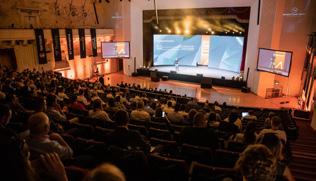

“Maintaining Altitude”
When and where?
11th-12th October at the Hilton Malta, St Julian’s.
What is it about?
The Malta Aviation Conference and Expo is an annual event that brings together aviation professionals to debate, discuss, and network, all to grow, connect, and strengthen the industry in Europe and across the globe. As one of the most important events in the aviation industry’s calendar, MACE aims to give industry players, professionals, and policymakers a chance to talk, form partnerships, and share best practices.
How can you benefit from this event?
• Engage in discussions with aviation professionals and industry players
• Connect and strengthen the aviation industry in Europe and globally
• Share best practices and learn about the latest developments and trends
• Access to debates on critical issues affecting the industry
• Opportunity to meet with policymakers in the industry
SiGMA 2023
“The World’s Gaming Festival”
When and where?
15th-17th November at the Malta Fairs and Conventions Centre (MFCC), Ta’ Qali.
What is it about?
Returning to its roots, SiGMA Europe hosts its annual Malta Week event, which brings together an expo, conference, and networking opportunities, with an international and diverse lineup of industry experts. It is a cornerstone for Malta due to its economic contribution.
How can you benefit from this event?
• Acts as a hub for some of the biggest names in the iGaming industry.
• Network, discuss the present market and draw up ideas about what the future could look like.

79 TECHMAG
GSE Malta Summit SiGMA
MACE iGaming Next
Casino Beats Summit
Bizdirectory



Abe Health
Abe Health develops AI-powered solutions to make personalised health-supporting services affordable for all.
kindzuro@abe-health.com abe-health.com
Be Communications
Be Communications is a dynamic company that provides sharp conceptual designs, quality print, and an integrated marketing communication service.
hello@bemags.com becommunications.com
Bettiwears
Bettiwears’ mission is to inspire people to fall in love with pre-owned fashion and with our planet.
+356 9956 0400 info@bettiwears.com bettiwears.com
Binderr
Binderr creates global corporate transparency by unifying business registries worldwide and streamlining corporate changes.
hello@binderr.com binderr.com
BrainTrip
BrainTrip’s primary goal is to unlock the hidden potential of EEG as a screening and diagnostic tool.
info@braintrip.net braintrip.net
Dar Bjorn
A first step towards revolutionising neurological community care in Malta. The first DAR Bjorn opened in November 2017 in the town of Qormi. It is currently home to 13 residents with severe neurological conditions.
+356 7920 9420 info@alsmalta.org darbjorn.com
Epic
Epic Communications Limited is a Maltese mobile network operator. It is Malta’s second-largest mobile network based on the number of customers.

+356 9999 9247 epic.com.mt
eSkills Foundation
The eSkills Malta Foundation is a national coalition of various government, industry, and education representatives who can contribute to increasing digital skills and developing the IT profession.
+356 2123 4710 info.eskills@eskills.org.mt eskills.org.mt
EY Malta
EY is a global leader in assurance, tax, transaction and consulting services. The insights and quality services we deliver help build trust and confidence in the capital markets and economies the world over.
+356 2134 2134 ey.malta@mt.ey.com ey.com/mt

Fyorin

To build the tracks for better business banking in the form of an ecosystem that financial institutions, like banks, can use to improve their value propositions or make more money.
support@fyorin.com fyorin.com
GO
GO is Malta’s leading communications services company. As Malta’s first quad-play provider, they provide mobile, fixed-line, internet and TV services to more than 500,000 customers.
+356 8007 2121 customercare@go.com.mt go.com.mt
Intercomp
Dell, iPhone, Samsung, Huawei, Philips, Nokia, Canon, DJI.

80 TECHMAG
Buy your laptop, smartphone, TV, printer, drone or camera using Intercomp’s Easy Payment Scheme.
+356 2291 6206 sales@intercomp.com.mt intercomp.com.mt
Malta Digital Innovation Authority
MDIA is the primary authority responsible for supporting all governmental policies that promote Malta as the centre for excellence for technological innovation while setting and enforcing standards that ensure compliance with international obligations.

+356 2182 8800 info@mdia.gov.mt mdia.gov.mt
Seed Consultancy
Seed is a boutique advisory firm based in Malta, focusing primarily on regulatory, tax and strategic advisory. We take a proactive and practical approach and aspire to become our clients’ trusted advisors by constantly adding value to their business.
+356 2141 4210 info@seedconsultancy.com seedconsultancy.com
Sorgi

Sorgi is an ongoing research project about opportunities for circularity in Malta, whose first outcome is an outdoor furniture collection for public spaces, highly critical of the booming construction industry. ahaobjects@gmail.com sorgi.mt
Sparkasse Bank Malta plc
Sparkasse Bank Malta plc aims to deliver personal, efficient, and effective solutions supported by a highly skilled and dedicated team of bankers.
+356 2133 5705 sparkasse-bank-malta.com
Tableo
Tableo helps restaurants of all sizes get organised, save time, automate bookings, turn more tables, collect

payments, reduce no-shows, and more.
+356 2033 0096 tableo.com
Tech.mt

Created by the Government of Malta and the Malta Chamber of Commerce, Enterprise and Industry to promote the national strategy on innovative technology.
+356 2226 2100 techmt.contact@tech.mt tech.mt
The Malta Chamber
The Malta Chamber of Commerce, Enterprise and Industry is an autonomous institution. Membership is open to any form of commercial enterprise in or from Malta. Its main objective is to promote and protect business interests.
+356 2203 2300 info@maltachamber.org.mt maltachamber.org.mt
Trusted Tutors

Trusted Tutors were set up to bridge the gap between students looking to upskill and tutors that can make that happen.
+356 7988 8248 admin@trustedtutors.com trustedtutors.com
World Pro Racing
World Pro Racing organises various professional virtual racing events and championships.
+356 2180 0424 info@worldproracing.com worldproracing.com

81 TECHMAG
The Metaverse is dead.
Long live AI.
The CEO of Meta Platforms, Mark Zuckerberg, is said to have killed the Metaverse, a virtual world idea he once pushed as the “next big thing” in technology. The move marks a significant shift in Zuckerberg’s vision for the industry’s future, with Meta investing billions of dollars in the initiative. Although there has been no official announcement or news conference, the decision has caught the attention of industry experts and observers.

While Meta remains committed to AI, it will no longer pursue the metaverse concept. Reality Labs, in charge of housing metaverse projects, lost almost $24 billion between 2021 and 2022, including $13.7 billion just last year. But Meta will keep making things like headgear that are part of the virtual
world and aimed at niche markets like video games and cryptocurrencies.
Zuckerberg’s swift adjustment to emerging market conditions and knack for capturing the zeitgeist are among his strengths. The CEO is also a staunch advocate of AI and announced the creation of a new division centred on generative AI. The move is expected to benefit consumers and companies in various ways, with ChatGPT already transforming how people search for things online.
Now that the metaverse idea is dead, Meta will likely focus more on AI as it works to make creative and expressive tools and AI personalities that can be used in various ways to help people.
Ateam of researchers from the University of Malta and Orthopaedic Centre Malta have successfully developed a prototype for a new prosthetic hand based on an innovative approach that focuses on optimising the dexterity and intuitive usability of the system while simultaneously reducing the complexity of the overall design. This research is part of the MAProHand project, “Development of the mechanical and control framework for a minimal anthropomorphic prosthetic hand,” which started in March 2019 and ran until November 2022.
Professor Michael A. Saliba of the Department of Mechanical Engineering at the University of Malta leads the project. It also includes other researchers employed by the department specifically for the project and academics from the Departments of Systems and Control Engineering and Artificial Intelligence at UM.
The team worked to design and build a hand that can be controlled using an electroencephalogram (EEG) headset. The
EEG headset reads signals from the user’s brain and translates them into commands for the prosthetic hand. The hand is capable of a range of movements, including grasping and releasing objects and can be programmed to perform specific tasks. According to the researchers, the prosthetic hand significantly improves over existing models. It is lighter, more durable, and more responsive to the user’s commands. It is also more affordable than other advanced prosthetic hands on the market.
The researchers are now working on improving the prosthetic hand further to make it even more responsive to the user’s commands. They also hope to make the hand available to people worldwide who need it.
Creating this advanced prosthetic hand is an exciting new development in assistive technology. It shows that with the right resources and expertise, researchers can develop innovative solutions that can make a real difference in people’s lives.
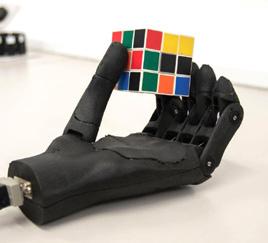
82 TECHMAG TechTalk
Maltese researchers develop an advanced prosthetic hand
Read the latest editions on bemags.com Follow us on

Part of the fastest growing telco group in Europe serving 1 million businesses everyday Contact us now to supercharge your business digital transformation Connecting you to the future epic.com.mt/business





















































































































